#which only had this under construction so found the developer from the construction signage
Explore tagged Tumblr posts
Text
12 KANDA shared office building
Design by Sinato Co and List Development/ReBita
Construction photos, model shots, renderings on their Instagram, @12_office_official

#I don't want to admit how long it took to track this project down#I had to start with the an apartment listing for the black building on the right#to find the address for street view#which only had this under construction so found the developer from the construction signage#and then in their press archive was the name of the project and the architect 😔#kind of a shame its just a shared office space#but the stairs are still great#arch ref tag
223 notes
·
View notes
Text
No Grace Falls Upon the Careless
My BDRRM Kwentuhan
I can recall how a Theology professor of mine once said that “in disasters, there is grace,” while she was discussing a lesson in class. I took note of that a few weeks ago because that was just one of life’s ironies that dawns upon you every now and then. At some point I agreed to it—especially how, as Filipinos, it can be evident knowing how resilient we are. Filipinos can be seen managing to flash out smiles amid the flooding and chaos. We manage to swim in our own pieces of tragedy that floods us every now and then, but I realized that this shouldn’t really be something we should be proud of. Yes, resilience is important, but it shouldn’t be romanticized; the chaos behind it shouldn’t be taken for granted. At some point, again, I started to question my professor’s statement. How was it going to be true for those who didn’t make it? Knowing how difficult it must be for my fellow citizens, this activity made me ponder more. With my interview with Kagawad Edgar Estigoy, the barangay official assigned to disaster management, I picked up numerous points that made me analyze my own community’s situation and whether or not the quote I acquired from our teacher applied to the people in it.
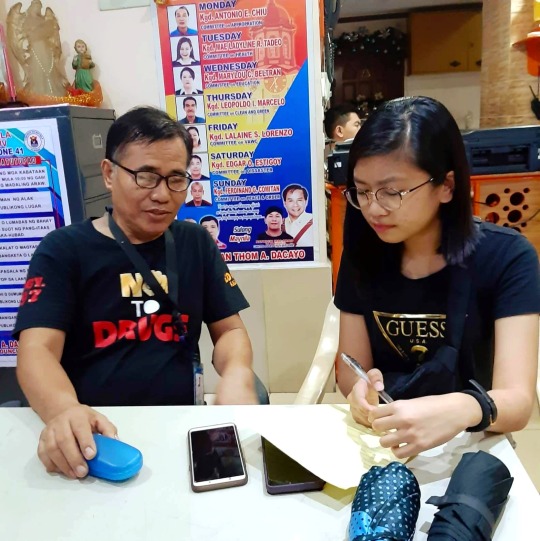
According to the notes given to us in our NSTP course, hazards are “any phenomenon, substance or situation, which has the potential to cause disruption or damage to infrastructure and services, people, their property and their environment.” Knowing how anyone can be subject to danger no matter where they reside, I had Kagawad Edgar identify the hazards that had been present in our community—Brgy. 397, Zone 41, Sampaloc, Manila.
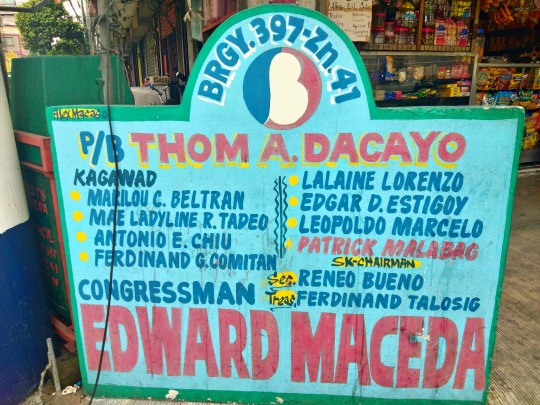
According to him, the heaviest calamities that had hit the barangay were typhoons Ondoy and Piping. He referred to these as the worst as he recalled how the barangay was in deep flood for hours due to heavy rainfall and winds. The streets surrounding the community, especially España, weren’t fully developed as the drainage systems weren’t functioning well. These changed when a mega dyke was built in Blumentrit to mitigate the situation as told by Kagawad Estigoy. Another hazard that had hit the barangay, but fortunately has not affected it much, were the earthquakes. To be more aware or cautious about these things, he mentioned that we are already living in the age wherein Information Technology is very accessible and prevalent. This helps the council be on the lookout for incoming calamities. Indeed, the term “high tech” has been familiar to us, and this has paved the way for people to communicate and disseminate information easily. Aside from this, Kagawad expressed that there are organizations involved in providing people information like the Bureau of Communication Services, National Telecommunications Commission, and PAGASA. They also have what they call a “Public Address”, barangay tanods that roam around, and volunteers to help spread info. Basically, they become aware of an incoming disaster when they get the “nationwide notification” or warning; they, then, notify the residents of the barangay. What probably is a good thing amid all the disasters is how the community is not badly affected no matter how often these come. To give examples, Kagawad Estigoy cited how the recent typhoon Tisoy came yet the worst we’ve experienced out of it were heavy rains and strong winds that thankfully didn’t come to the point of destruction compared to the regions that had to go through being badly damaged like Isabela, Cagayan, Mindoro, Albay, Bicol, and Leyte (as cited from the interview).
When it comes to assessing people at risk in the community, the ones who fell under the most vulnerable to hazards were those who were near establishments made out of wood, which were the areas that were also considered the most dangerous within the community. This is because wood can easily catch fire which--something that cannot be easily put out. This kind of establishments would also be easily “washed out” by floods and destructed by winds. But in the community’s case, very few infrastructures are still made out of wood as most (within the streets of Moret, Galicia, P. Noval, and Tolentino) are already concrete.

According to Kagawad Estigoy, in times of disasters, those who will be largely affected would be the workers or “mga taong naghahanap-buhay”. He said that we cannot be sure with the financial stability of anyone and meant that not everyone has jobs that can sustain each day which can be affected with a single hit of a storm. Despite this, in terms of vulnerability and facing calamities, the interviewee said that the residents are not really affected to the extent that services will run out as the people are always willing help each other out, as well as give or donate resources. On the other hand, the safest place that can be located within and near the barangay were the open spaces and evacuation areas in the Paaralang Juan Luna and the field of University of Santo Tomas. Kagawad also added that the concrete establishments that surrounded the barangay were informed to be open and accessible to all to be evacuated in during emergencies, especially the building wherein the Chairman of the barangay resided. He said that they were tasked to give way to those who badly needed help or shelter and not be selfish with space. So far, there isn’t an existing problem that the barangay is facing which prevents it from being a better community to live in or from rising up again because in the first place, the fall is already prevented.
In assessing the capacity and disaster management, the council of barangay 397 equips itself and the community with supplies that is ready to use in times of dangerous situations. These evacuating tools include first aid kits, wood cutters and saws (incase of situations that would require removing big obstacles like trees that would fall on cars or roads), machines, ropes, emergency vehicles, and more. The council also makes sure to disseminate information to the community when there is an incoming danger. To help the people be prepared for any disasters, activities like fire drills and earthquake drills are conducted for the safety and awareness of everybody. The barangay council, community volunteers, and support from NGOs all help in the protection and preservation of peace and safety of the barangay.
My Community Walk
After gathering information from Kagawad Estigoy, I took a community walk to assess and check if the data I have accumulated matched the barangay’s situation. Below are what I have captured with regards to the hazardous areas, safest places, and best practices around the community.The hazardous places or spaces that I have captured included (1) infrastructures made out of wood since, as the interviewee had mentioned, it could easily catch fire and is feeble enough to be destroyed by strong winds and floods,
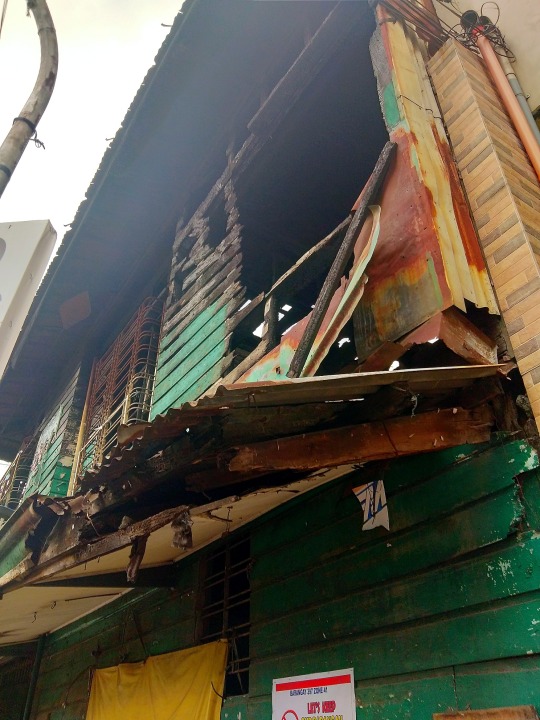
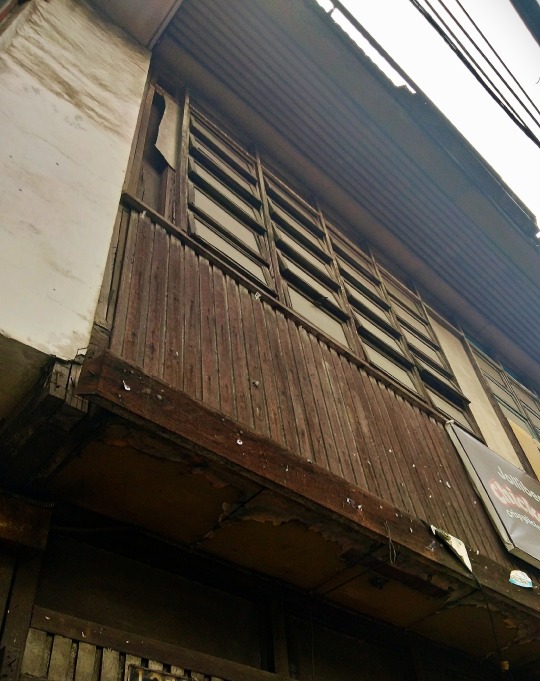
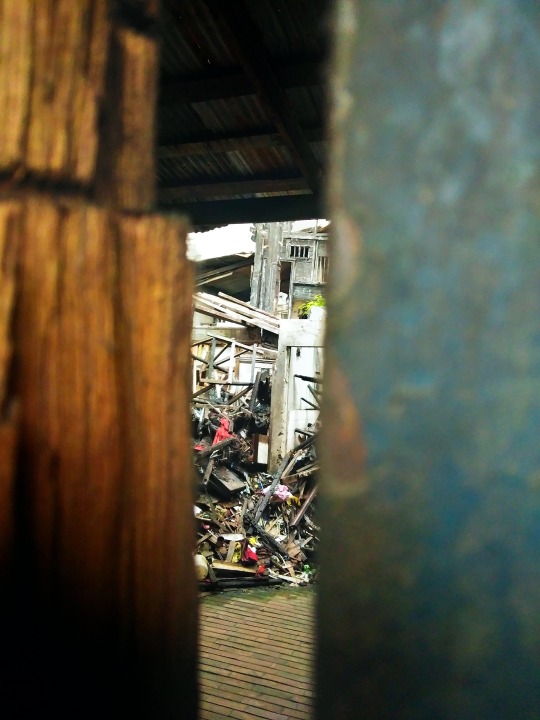
(2) sidewalk and road blockages/damages that have no proper warning signages which could put people in danger such as making them fall, trip, or are simply being obstructions,
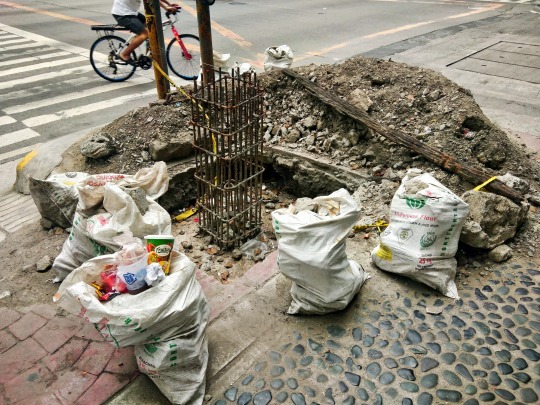
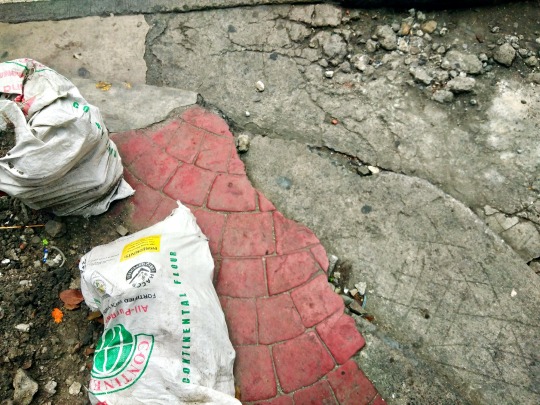


and (3) open construction sites that are too close to roads and establishments that is hazardous for many passersby that do not have PPE (Proper Protective Equipment).
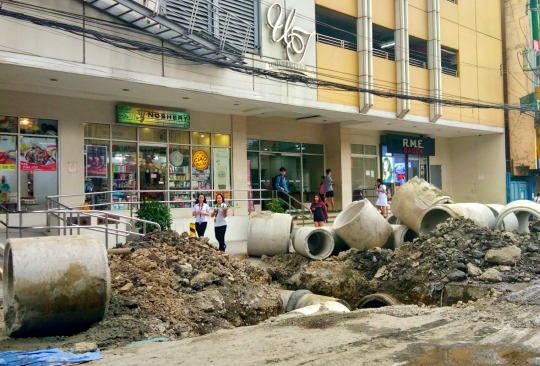
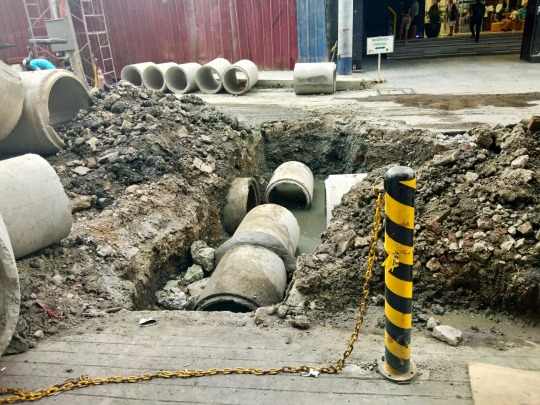
Some issues I have noticed were (1) the presence of too many electrical wirings that were all messily looped together which can be a cause for fire

and (2) the presence of heavy-duty equipment near construction sites that were just lying around unsecured.
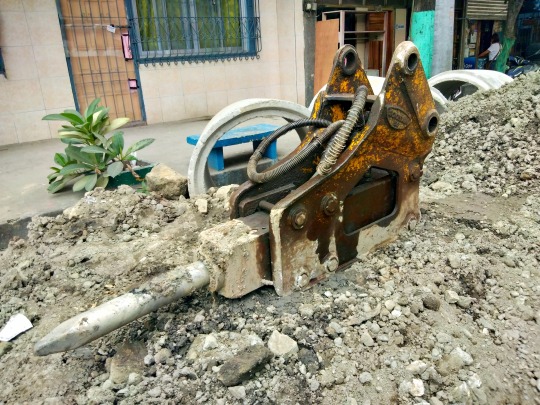
A hazardous practice I have captured is the construction workers act of not wearing PPE’s while working which could harm them while they do their jobs.
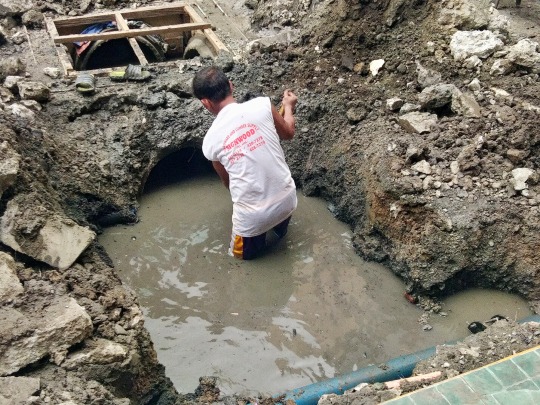
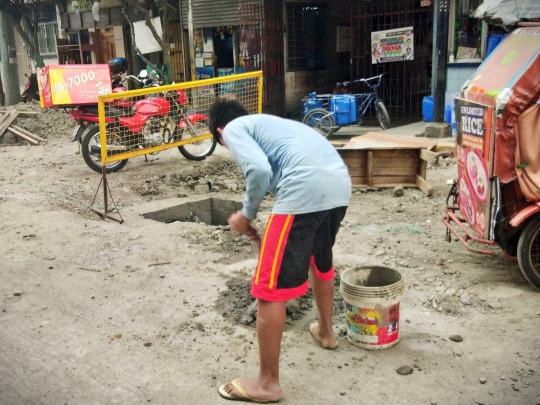
The safest places, as mentioned earlier, are the (1) UST field,
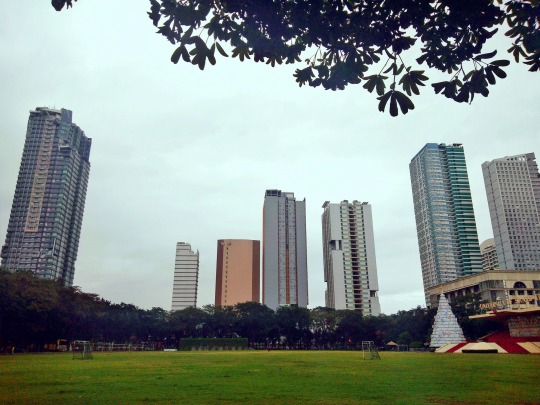
(2) Paaralang Juan Luna,
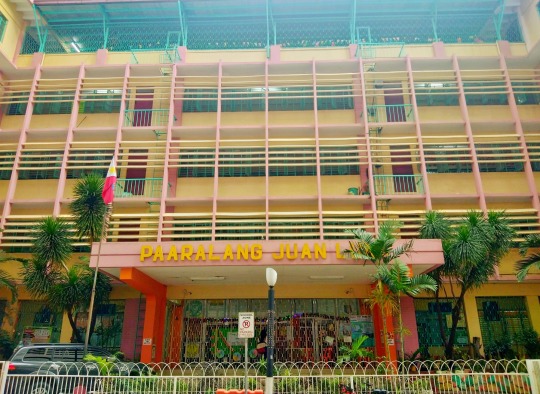
and (3) the barangay hall itself which is also where the barangay chairman resides.
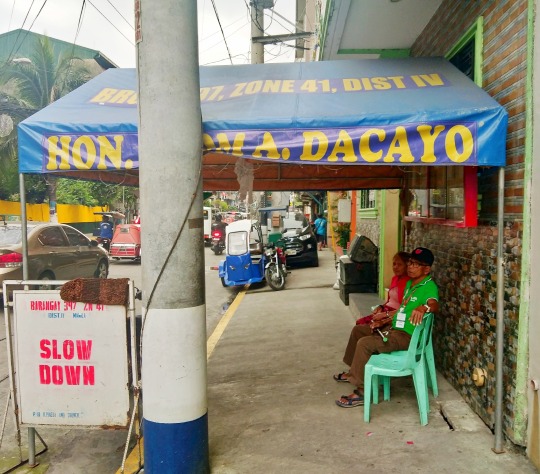

Last but definitely not the least, some best practices I have witnessed in the entirety of my community walk were (1) the proper segregation of waste (as there were trash bins in almost every corner in the community) and designated areas for recyclable materials,
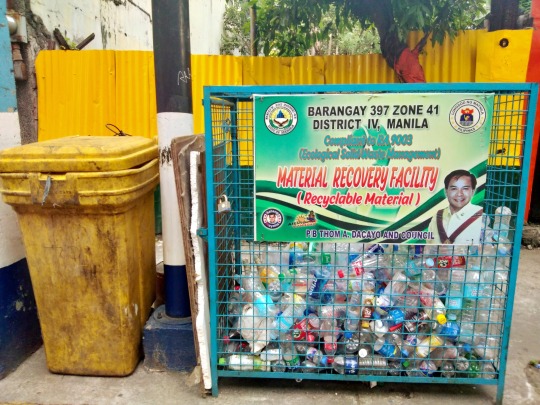
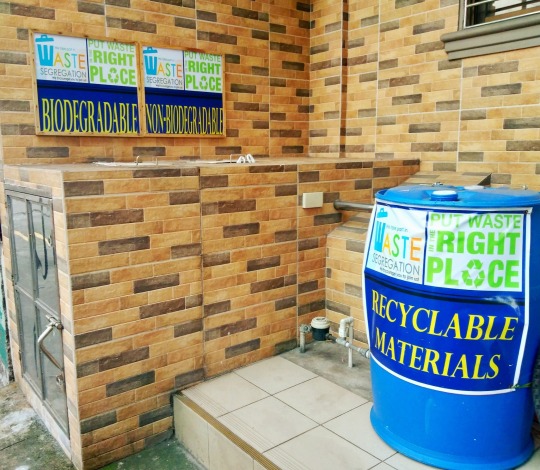
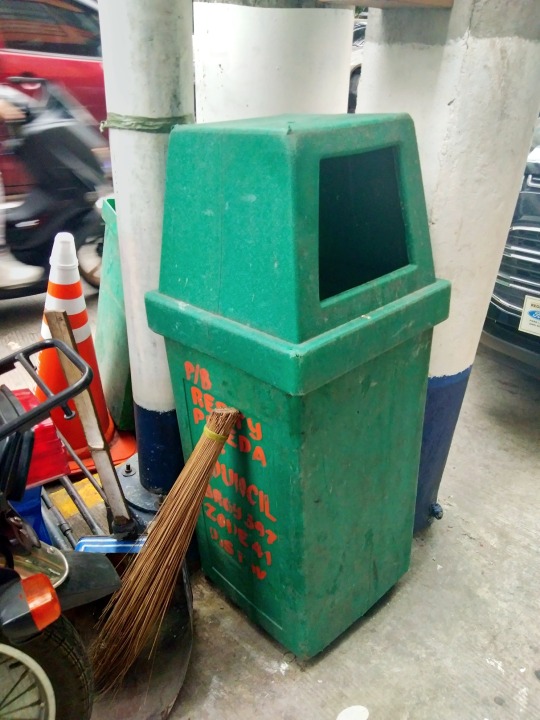
(2) the presence of many security cameras (for proper surveillance) and a warning horn (for important announcements),

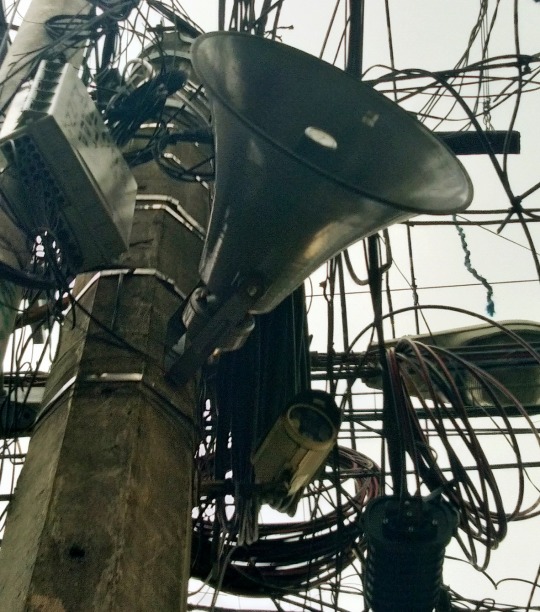
and (3) ready-to-go barangay vehicles that were provided for disaster response.
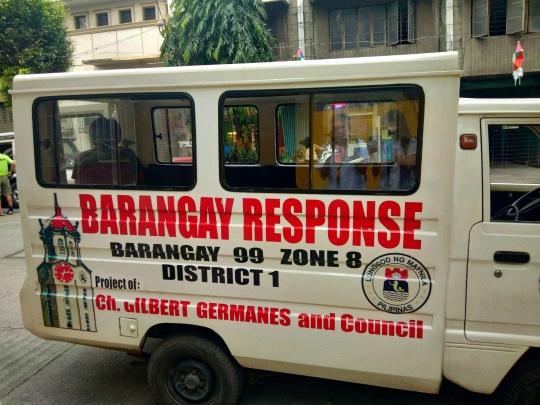
Because of the interview and community walk, I couldn’t help but also notice the issues that can be perceived to be small but can have a lasting effect. An issue I found confusing was how the barangay was missing a DRRM plan, which although crucial, seemed to be taken for granted since I was told there wasn’t really a need for it because the plans were all connected and “programmed” anyway in the council; that they were simply wired to be informed already. Another issue fell more under how the people don’t really follow the rules set out for them and their common good, even in the simplest things like proper waste disposal and taking segregation bins for granted. Pieces of trash can still be found scattered around the area despite having been provided with trash bins. These, in my opinion, are issues because it can affect everyone residing in the area and can be a cause for a domino effect that will gradually build up in the long run (ex. being a big factor for floods and health issues).
The mere fact that people continue to be careless despite being provided with a chance to come up with a solution (programs/plans) or have a solution (trash bins) right before their eyes tells something about the discipline that is lacking within the masses. This also influences people to go on with their misdeeds. This does not only apply to this particular community but to the whole country as a whole. It reflects the lack of effort of the citizens to do the simplest things to contribute to the betterment of other people and the environment. This is why change hasn’t come, and why a lot of bad things prevail in the country; because we can’t even follow something simple due to being undisciplined and careless. We need to be able to address this because people don’t even realize that due to these, more and more add up to being under the vulnerability list.
To increase the capacities of a community, it needs to start within the individual. The practice of thinking of the welfare of others should always be put in mind because as long as we care and live for the common good, there is hope. Perhaps, what the local government can do about it is conduct seminars and put up more infographics that are eye-catching will actually have an encouraging effect to the audience—activities that will leave a mark which will be remembered for a long time and can be taught by the elderly to the younger generation. Also, the local government can have somebody assigned to conduct a monthly check of the community area. Information can also be disseminated online to make use of the cyberspace where influence is strong and where almost everybody can be involved. But, all this cannot be possible if discipline isn’t present and maintained. There will not be grace amid disasters if people do not actually learn from what they did wrong which contributed to the worsening of a situation that eventually leads to a disaster.
2 notes
·
View notes
Text
Alexandria, VA
After a quick bite for breakfast at our hotel, we took the Metro to head over to Alexandria. We wanted to stop at sites related to African-American history that Rebecca Grawl, the Lincoln assassination tour guide, informed us about. We set out to visit them all on our third day in the area. The first stop was a quick walk over to the site of the Freedom House Museum and the Shiloh Baptist Church. According to the historical sign, the latter was originally a place for free African-Americans to find refuge. A historically Black congregation has flourished at the West Street church and has hosted prominent visitors like Representative John Mercer Langston, Dr. Dorothy Height, and President George W. Bush. Close to the site of this church is the Freedom House Museum, which was once the headquarters for one of the largest slave-trading companies in the entire country, Franklin and Armfield. The company's owners held enslaved persons in pens before shipping the majority South to places like Louisiana and Mississippi, where they could charge for higher prices as the demand for enslaved laborers was high. Until 1861, the brick building that each of us stood in front of was owned by slave trading companies. Though the Freedom Museum is currently closed, they have an important role in sharing experiences from the enslaved that were in Alexandria. These two sites show the progress that has been made in developing better opportunities and experiences, but one also shows the constant presence of a painful past that takes decades to unravel. Getting in touch and learning from that past is possible for all citizens with the Freedom House.
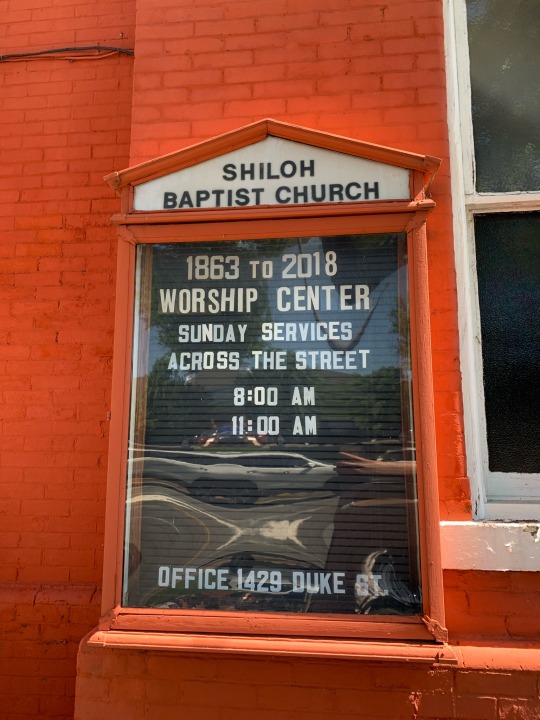

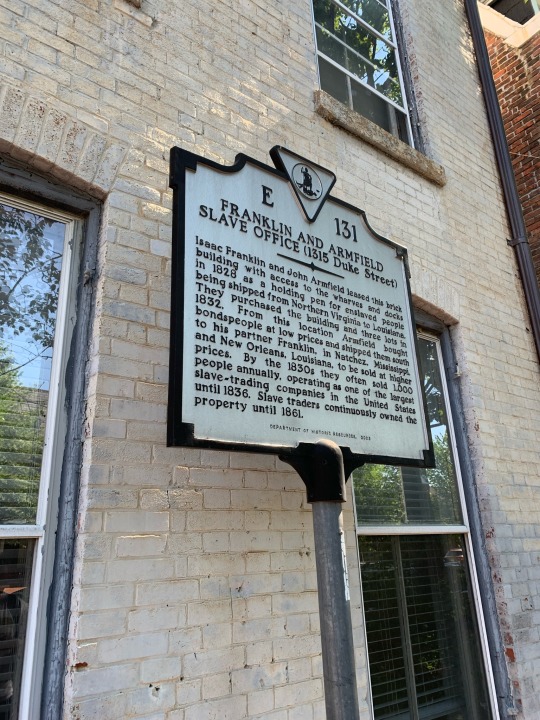
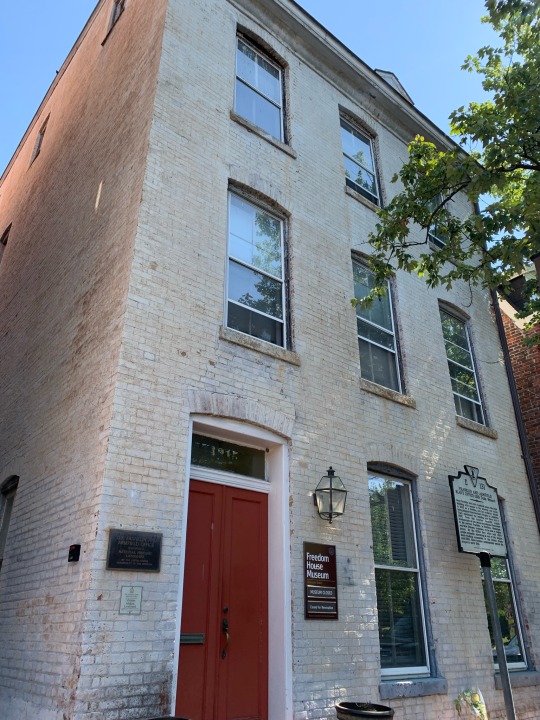
After a long walk, we had finally reached the site we all had been anticipating most for our trip to Alexandria: The Contraband and Freedmen Memorial. As soon as you walk up to the cemetery, you see the sidewalk has different colored bricks. This symbolizes graves of freed African American men, women, and children under each tan brick. This alone struck a tear from each of us. We all knew this was going to be a difficult monument to grasp. You walk into the gates of the cemetery to see two graves that have created life size interpretations of coffins for an adult and child. The cemetery was dedicated in 1864 by the Union forces for freed African Americans in the area. Due to the amount of enslaved people making the journey to freedom, many had poor health from living conditions, prior treatment, and the journey alone. The cemetery was for those people in this area. Soon after the war ended, the cemetery was abandoned. Over 1,700 people are buried here, but their graves would not be respected or acknowledged again for over one hundred years. On the site, there was once a gas station and office building that desecrated the grounds. The same cement floor that once was the gas station’s floor is still there to house the monument. The archaeologists worried removing it would disturb and destroy too many graves. It is hard to imagine 20th and 21st century people coming and going to fill up their tanks where so many people were laid to rest. Of course those who constructed both buildings cannot be blamed as they most likely had no idea. There are likely more sites like this to be discovered throughout the country. As you go further into the memorial, you see a grand statue titled The Path of Thorns and Roses that breathtakingly details the struggle and triumph of African Americans. On cement panels, the memorial describes life in the area for newly freed slaves. Education, shelter, family, and work are all discussed. One of the most touching pieces of the memorial are the small additions besides names of those buried that say: “Living Descendant Found.” This is encouraging to know that these people who fought for freedom still have survivors today. This memorials' location can describe the perspective for many Americans who do not understand why African American and enslaved peoples history is so important to learn about and is increasingly being discussed. Directly across the street there is a white cemetery that is still used from the 18th century. How does one survive but another doesn’t when both hold free, American citizens? The cemetery was long forgotten about, along with so many other pieces of history that our white ancestors felt were not important, all because of the skin color of those who were buried. This is the case for many “hidden histories'' across our great nation that are finally being told today. We are so thankful that today we are in a place where not only can we learn one side of history, but now we are able to see everyone's side.
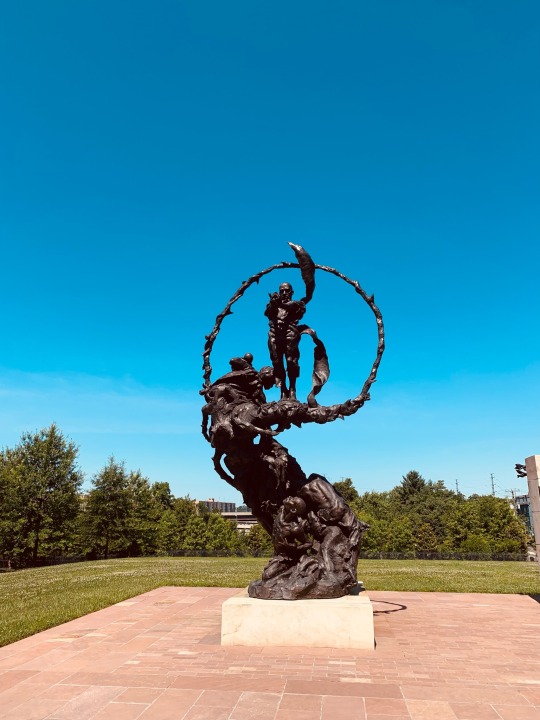
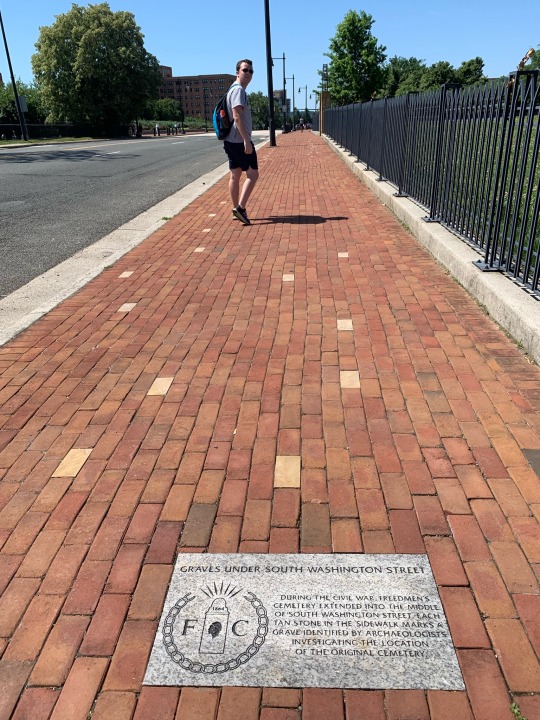
On our way to see the relatively new Loving v. Virginia signage, we encountered another place of worship called the Beulah Baptist Church. We learned from the church’s historical marker that many freed enslaved people sought out the First Select Colored School led by Rev. Clement “Clem” Robinson beginning in 1862. Morning and evening classes were packed with African-Americans seeking a quality education. When the Union began to occupy Alexandria, the Beulah Baptist Church congregation was the first African-American church in the city. Education was central to Beulah’s cause ever since it was set up in the neighborhood. We were trying to find the Loving v. Virginia signage for about 10 minutes before finally locating it on a lightpost. It details the Law Office of Cohen, Hirschkop, and Hall that was located at 110 N. Royal Street. Richard Loving famously told his lawyer fighting Virginia’s ban against interracial marriage to “tell the court I love my wife and it is just unfair that I can’t live with her in Virginia.” Richard and Mildred won their case and similar interracial marriage laws were struck down acorss the entire country after the Supreme Court weighed in. Both places are incredibly meaningful and deserve to be remembered in Virginia.
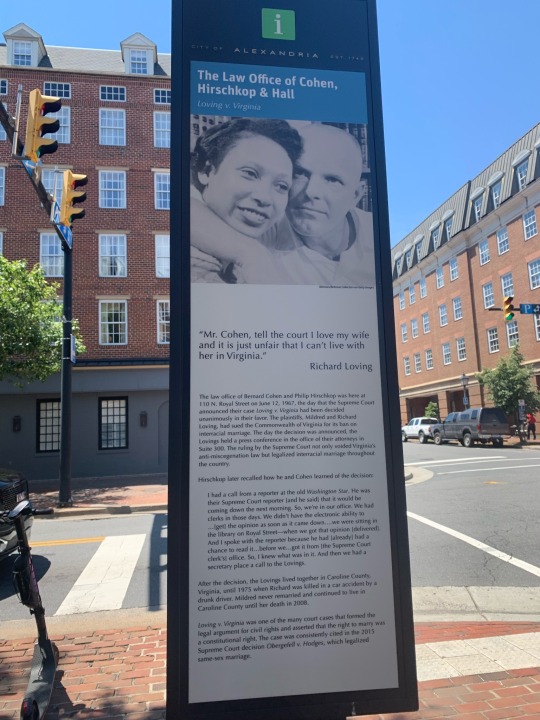
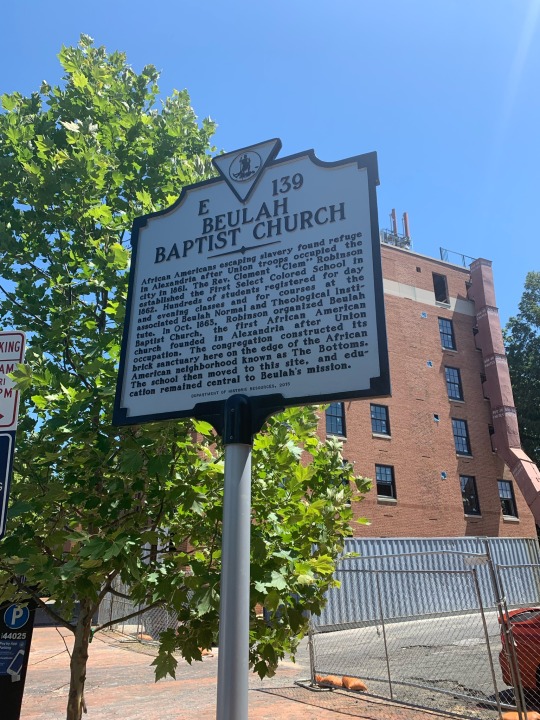
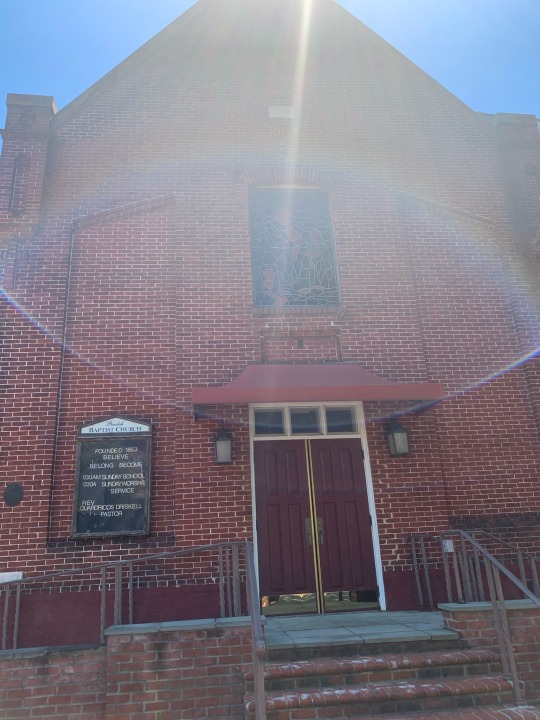
Alexandria was full of Easter eggs for us history buffs. On the way to the Alexandria Library, we were shocked to see yet another historic African American Church. The Roberts Memorial United Methodist Church began in 1834 with prominent members of African American society that attended. The church's congregation was originally a part of the white Trinity Methodist Episcopal Church, but founded their own congregation and created a space for worship. Not only were they a church, but also offered basic academic education in their Sunday School lessons. Notable visitors to the church were Booker T. Washington and Frederick Douglass. We were all very excited when we came across this important site. Next, we were able to visit the Alexandria Library to see the memorial plaque to the 1939 sit in. Five young African American men walked into the whites-only library and requested library cards. When William Evans, Edward Gaddie, Morris Murray, Clarence Strange, and Otto Tucker were rejected, they sat down and began to read. Their peaceful resistance was barely recognized. Instead of integrating services, the city constructed a separate library space called the Robert H. Robinson Library in 1940. In the wake of Civil Rights protests, the library system only began desegregating in 1959. Thankfully, the young men’s efforts are now recognized on this plaque and in the old African American Library, now a museum.
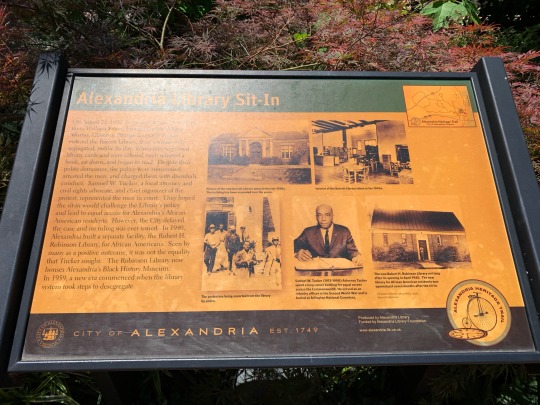
Though we did not mean to encounter the burial site of at least 30 Confederate soldiers at Christ Church on Washington Street, we did when on our way to our last stop. The engraved stone marker that indicates this was erected in 2002. They were disinterred from the Alexandria Soldiers Cemetery to be placed at their current resting place. Interestingly enough, a Black Lives Matter sign is hung on the fence right next to where the marker sits. It is remarkable to see how quickly the values of the City of Alexandria and its residents have shifted. We saw Pride flags and progressive signs throughout our walk through the area. The Confederate marker just seemed out of place. While the graves should likely not be moved, balance and context are the best way to address their presence. This exists with the placement of the BLM sign. It is not actively disrespecting those that died. It simply allows all to feel welcome at the church and see themselves represented in their values.
Our last stop in Alexandria was at the Edmonson Sisters Statue. Mary and Emily Edmonson were due to be sold in the notorious slave block in Alexandria owned by Joseph Bruin. The sisters, alongside 75 other enslaved people, attempted a rebellion and escape on the slave ship Pearl. Sadly though, the attempt failed and the ship arrived in Alexandria. The fate of many of the enslaved people would be to go deeper south, but thankfully for Mary and Emily, their lives took a different turn. Though the sisters were bought by Bruin and destined for a horrific fate in the deep south, the work of abolitionists changed their lives forever. Abolitionists raised enough money to buy the sisters freedom and allow them both to live a free, happy life. It is stories of triumph like these that allow for all Americans to see the heroism and bravery of our ancestors before us.
#alexandria#va#monument#history#enslaved people#cemetery#loving v. virginia#memorials#edmonson sister
0 notes
Text
Something that still doesn’t feel real to me the sequence of events was dreamlike in every way shape and form. The only reason I can confirm it feels real is because there were other people there to experience it with me(family and friends). I was so excited I had trouble sleeping on the night before and the plane ride wasn’t too long, but I did manage to sleep there(thank goodness there wasn’t any screaming kids). My lack of self awareness meant that I was more more excited then I thought I was. As the plane began its descent back to earth I remember seeing an abundance of green forest that immediately surfaced feelings of nostalgia and the excitement of witnessing something completely new to me. Although I was used to seeing leafy green forest all my life (Pacific Northwest kid) , the Japanese forest that I looked out at was filled with different foliage then I was used to seeing. Something that I thought was so standard and unchanging looked so different in another place. A landscape of rolling hills covered in trees looked different in each of the locations I had been to in my life, a realization that hit me then and there.
The plane touched down and of course my twisted mind had yet another cynical thought “cool we survived a possibly fatal plane ride”.
Side Tangent Inc.
Before I used to wonder why people got so upset when they did a lot of air travel and now that I have gotten older and participated in a lot of plane flights on this trip, I can see why people are angry with the way plane travel is treated. The flow of free travel is slowed by a lot of bureaucratic and unnecessary damn dams. Security is a long slow process because people are afraid of the 1% of the population that deals with terrorism and things like drug and human trafficking, I mean what are we even fighting about now a days really? Then when you get to a country you have to deal with Immigration and customs just so your country, which is an abstract social construct and ideal in the first place, can keep track of where you are going. . . well I guess in a way the government is a business and you are it’s merchandise . . . “where is my taxpayer going off to can’t have my property running away”, all through this and that you don’t get much sleep, sit in uncomfortable chairs, and must stand and wait in so many lines that patience is as thin as the generic cookies you buy at the store. All this time that this is going on you have to deal with lugging these human sized bags around.
After we get past all the hoops and loops I remember standing there and reading where we were and being internally happy to see Chiba-Kun. I had no idea Narita international airport was in Chiba, my favorite fictional character, whose life must be mine in another carnation, Hikigaya said something about this character. You know for cynical people that don’t really take pride in many things we both have a lot of pride for where we live. Tacoma is one of the few invisible border lined areas that I take pride in 253 fam!
The bus ride was not something that I was looking forward too, but it was cool to be able to snap some pictures before we left for our hotel, being able to look outside at all the signage, and of course seeing all the right hand drive cars. Driving on the left side is something me and my friends used to joke around about back in my high school days. It was really fun for me seeing it in singapore and here. Who knew they used Toyota Cressidas for taxi cabs? I had always known them as drift cars, fender mirrors and all.
Washingtonians do bring the rain around with them
After I had dinner with my family, I went to meet with my friends in Shibuya station. Because of my lack of knowledge of the train system and my inability to use the Japanese that was locked in my head somewhere something as simple as getting from one train station to the other became a fun adventure. I said goodbye to my family, asked the hotel staff for basic instructions, and began my journey alone. Gray clouds formed the second I stepped outside it had begun to rain. With the rain came the smell of wet asphalt, the pitter patter of the small drops hitting different surfaces, the soft impacts on the top of my head and my face, and the feeling of calmness reminding me of home which had followed me across the ocean. I took a deep breath and looked all around me to see the locals unfolding their umbrellas, something I hadn’t used in years. Wanting to fit in I walked into the nearest Seven-Eleven which should have been a boring task, but to me I was feeling a mix of emotions that I couldn’t describe. My mind ran as I thought of the times my dad, sister, and I would go into Seven-Eleven to buy slurpees. All the good feelings stayed in my heart after all this time. I purchased my first thing ever in Japan. . . an umbrella.
The Hamamatsucho Station was two blocks from my hotel and was busier than anyplace I had ever been to in my life. As my umbrella was awkwardly folded in, the calm feeling that I was harboring shifted to a slightly panicked I have no idea what is going on here vibe. I sat there awkwardly and watched how the train system was used. Not noticing all the helpful signage, I put 60 yen into the ticket dispenser I made my way to the Yamanote line which was headed to Shibuya. The train was crowded as people were finishing up with work or school, people will leave before more people get on right? Was something I was thinking, but as we pulled into Tamachi Station I found myself in a sandwich between a businessman and a businesswoman. . . I hadn’t rubbed up against this many people in 10 years. The last time being during the one high school dance I went to.
The other train was far more crowded than this
I think the trains are pretty cool though
I got off at the next station, Shinagawa, for a couple of reasons although it’s probably normal for Japanese people to be that close to others, for me a seattleite it is awkward. The second thing was I needed to talk to the Eki In or station attendant about my underpayment. It was one of my first times using Japanese in Japan and it went about just as bad as you expect it to. The broken Japanglish was the best I could manage, but I think between my bad Japanese and English the nice attendant understood and told me to see the attendant at shibuya when I finally get there. A couple stations later and I was at Shibuya Station. Easy enough right? Now to find the Hachiko statue. There are signs which point straight to the statue, but being in my panicked state I failed to calm down and see the signs with the dog symbol and the arrows. So instead I saw a picture of the statue on a wall and stopped the first two young dudes that made eye contact with me. “Sumimasen. . .doko desu Ka” I said pointing to the picture. I was expecting them to tell me and go about their merry day, but instead they walked me right to the statue! Thanks friends I hope we will be able to meet again in some way shape or form.
So there I was at the Hachiko statue, star struck at the abundance of signs, people, and lights at the famous Shibuya crossing. The smell of tobacco, rain, food, and people drifted about as I sat there just taking it all in under my transparent umbrella. There were two things I had realized while standing there like the tourist I was. It was much easier to develop Japanese proficiency as I was sitting there practically eavesdropping on every conversation I overheard. The next thing I thought was wow I am really useless without my smartphone having service and I don’t know how people scheduled meeting each other without cellphones and all the affordances we have today.
I had left an hour early for what was supposed to be a fifteen minute trip and even after all my hiccups and slip ups I sat there thirty minutes early. My mind, like it often does, began to wander. Who else is going to meet me today? Am I going to be able to communicate with my friends? What’s going to happen tonight? While is was there observing and amidsts my thoughts. It took me longer then it should have to recognize the sound of my own name being called, but it was there in the sea of people. A girl was calling my name . . . huh that’s weird I thought I thought my other friend was supposed to be here first.
This is Pretty Personal >////<
What happened next was the most magical 15 minutes of my life, it’s almost too embarrassing to write about. For me (loner, nerd, with low self confidence) talking to and being with a pretty girl alone to have a conversation is not something I even imagined happening, as a matter of fact it could have been my imagination. To that girl it probably meant nothing, but to me and that moment I was wishing for time to pause, or at least slow down. It was the world to me being there in that moment. So many feelings that I thought had died resurfaced. The feeling of liking a girl and being nervous was something I had last felt my senior year of high school four years ago. It had been a millennia since I had cared about my appearance or the way I looked.
Thoughts
Do I smell bad right now? Is my hair goofy? Is my outfit okay looking? Was that funny, stupid, offensive, or all of the above? Is the gift I got good enough? What does she think? Was that weird or awkward? English Essay . . . but I’m not confident in my own english skills. . . I’m not confident in many skills or anything really. . .My ESL instructor told me to have the learner read it. . . and I like the sound of her voice better than mine. Please don’t stand that close I’m not used to that >///<
I had forgotten what it was like to be that self conscious. I still remember many details of those fifteen minutes of my life. . . The awkward use of my bad Japanese, the pauses, the silence, the smiles, her eyes, the way she put lipgloss on, everything is memorable to me. I wished time would go like that indefinitely awkwardness, silence, fidgeting, and rain included.
“I’m sorry now that you’ve come here it starts to rain”
“No I’m happy I kind of like the rain . . . it reminds me of home”
Oh god that was a Weird thing to say wasn’t it dumb me.
Smoking is still common here
So many Lights
Ramen Got Me through college, but it didn’t taste this good
After what was a subjectively weird length of time that was objectively fifteen minutes, my good friend who is a boy showed up and the three of us went off to go get some ramen because why not eat it here in Japan? I was so stunned by all the lights and signs as we made our way through the various streets in Shibuya. Each building had a myriad of floors filled with izakayas, restaurants, and karaoke places. The vibrant sounds that matched all the lights filled the canvas to a scale I hadn’t been able to imagine in my mind. After twisting and turning we settled in a small shop in the heart of the metropolis. I had what my friend was having, a tonkotsu broth based tsukemen, being the bad vegetarian that I was I didn’t mind it when soup broths used meat bones so I avoided eating the meat that was included with the soup. Upon receiving my meal I was surprised to see that there were two bowls. One bowl was filled with noodles, while the other was filled with broth. I also ordered a beer with my noodles which was much larger than anticipated. Another friend of mine met us at the ramen place and then we went of as a group to an Izakaya where I exchanged my gifts with them and we all shared a drink together kanpai! It is hard to understand native speakers when they are going back and forward really fast, but I was enjoying just listening to the conversation as the gears in my head were turning trying to make sense of what little I could comprehend.
Tokyo Tower Is A great view at 2 am
So is this random side street
The last trial I had to complete was getting home after saying until next time with my friends. To be honest I don’t think I was all too drunk, but there were other forces at play, or at least that is how I try to understand it until this day. Perhaps it was a combination of the alcohol, jetlag, the excitement of being in Japan, and being around a girl I was crushing on, but for some reason much of what happened after being lead to the train station was very blurry in my mind. All of that mixed with the panic of being unfamiliar with the trainstation must have overloaded my feeble mind. I remember not having enough change to pay my fare, an older man helping me thanks dude(I had money I should have just used the change machine). Being extremely spaced out and not being to understand that I needed to transfer trains to get back to the Hamamatsucho station. So instead of going around harassing everyone I just exited at an unknown location and began my walk camera in hand. It was a good way to sober up, take time for photos, and burn some of those extra calories gained while drinking. I walked and walked and kept on walking, keeping the train tracks in view as I strided along. I was spacing out and thinking about what an awesome night I had claiming that I want to remember this night for forever and I lost the train track. I kept on walking until I found yet another helpful Conbini (convenience store) and asked the guy where the Hamamatsucho station was. It turns out I was pretty darn close and it was a block away. When I got back to my hotel, my loving mother greeted me with a “did you have fun” and to that I replied “too much” and passed out at around three in the morning.
My Trip To Japan Something that still doesn't feel real to me the sequence of events was dreamlike in every way shape and form.
1 note
·
View note
Text
Still down in Toronto, and will be for ~one more week probably. Apart from Christmas with brother and SIL’s family,I’ve mostly been sticking at my sister’s house, since the reason for my being down here was to give her and the eldest nephew a hand while she was undergoing and recovering from surgery (she’s recovering very well, yay).
Apart from the bra shopping I did before she went into hospital, and visits to her while she was in hospital, I’ve only made a few trips since
First was a lengthy shopping trip on Thursday the 2nd that took me down and through old stomping grounds like the Atrium on Bay, the Eaton’s Centre, then to Cumberland Terrace, under Holt-Renfrew, and into the Manulife Centre, around the Yonge-Dundas and Bay-Bloor areas respectively. Lots of change - Eaton’s has transitioned almost entirely to big-name stores it looked like, instead of the mix of big name and more unique shopfronts that they used to have. Way too crowded, loud and echoey. Almost nothing left that I recognized as being in the same locations as before, though I was delighted to see the toy store near the bottom of the southern escalators was apparently one of the survivors (assuming it’s not an entirely different toy store in the same location).
Only things on my shopping list I successfully located and bought where at Kitchen Stuff Plus on Yonge just north of Bloor, where I got a pair of cotton-lined silicon oven mitts (my sister has some and they are so much better for gripping things than the thicker 100% silicon claw gloves we’re still using at home) and a microplane grater (because I’m tired of trying to, say, grate fresh ginger or zest a citrus fruit with a box grater). Also went into many many handbag and luggage stores in quest of a new bag to replace my aging Swiss Gear sling bag, and didn’t find anything that was a) within my budget, b) had a good range of pockets that my tablet would fit in well, and c) had a long enough cross-body strap (the curse of being both tall and large - all those lovely bags whose straps are so short you end up weeping in frustrated envy). Though I was very tempted by a Hedgren cross-body bag I saw at a concourse level store just to the east of the entrance to Yonge-Bloor subway station. About twice my ideal budget and with plastic fittings instead of metal, but a brand I trust from past purchases and with a really nice layout.
Cumberland Terrace is once again undergoing renovations (is it ever not?) so the bottom level in particular was almost entirely empty. I was amused to see that Marquis Jewelers on the ground level was still there - though, sadly, having a going-out-of-business sale.
The Manulife Centre has been renovated to the point I barely recognized it (also, all that white marble? Horrible design choice - very cold looking and echoey). Since I’ve been having vision problems over the last half year plus, and my old optometrist's office was right there I popped in to see if he could fit me in for an appointment, and lucked into an appointment for the very next Monday.
Which was, of course, my very next outing. Bad news - I’m developing cataracts. Good news - it’s cataracts, which are extremely treatable, and not anything more worrisome (based on my initial description of the symptoms I’d been having, he was at first worried it might be a detached retina, while my main worry, given I’m, Type 2 diabetic, was it might be macular degeneration). I actually had my fingers crossed for cataracts (my Dad had them in his 50s, and as already mentioned, they’re extremely treatable) so I was therefor extremely relieved by the diagnosis. So now I have an appointment with an ophthalmologist later this year, which I’ll have to return to Toronto for (could have gone for them trying to get me in with someone up north, but given the patient-specialist ratios I figured Toronto was likely to be a speedier choice).
Which led to me going on another outing today, to see just where the office of the ophthalmologist is for when I’m back down for the appointment. Spitting distance (almost literally, at least with a tail wind) of a subway station in my old neighborhood, so then I look a walk along Bloor over to Bathurst just to see what was still the same and what was changed. Nice to see places like Noah’s Natural Foods and the Pizza Pizza just over from it still there, and smaller places like By The Way Cafe too. Sad to see that Dooney’s and Honest Ed’s are both gone (the latter now being a big hole in the ground with multiple construction cranes sticking up). I couldn’t tell if Book City is still there or not - the location appeared to still be a book shop of some kind, but the old black & yellow signage was gone and with my current crappy vision I couldn’t read the neon tube signage in the windows beyond something about buying books and music and something else.
Very happily popped into Cobb Bakery for a couple of their berry-and-custard danishes (raspberry for my sister, cranberry for me). I was disappointed to see the place I used to get really good fish & chips (if I’m remembering storefront shapes correctly) is now a Poutinerie, Which, tempting, but I would spork a man for a good fish & chips after so many years without any. All the places I used to frequent for it are, sadly, long gone - no more Penrose or Cas.
One nice thing - I finally found a new handbag! Was thinking of going back for that Hedgren bag I’d been tempted by, but decided I should probably poke around at a few more places before purchasing. Got off at Eglinton Station on the way south, didn’t even leave the station - there’s a tiny luggage & handbag store tucked in beside a woman’s wear store at the south end, just up from track level. Wandered in, very first bag I looked at had an excellent layout of pockets and was well within my budget ($24 CAN before taxes). Brand I’ve never encountered before - Baby Fish. Long enough strap, metal fittings, fabric some kind of canvas that will hopefully be reasonably durable, and I could pretty much right off tell what pockets i wanted to use to sort what things into (always a good sign). So I happily snapped it up and transferred all my things over from the sling bag while I was riding the rest of the way down to switchr to the Bloor line. When I was wandering along Bloor later, I also stopped in at Inti Crafts (a store I used to love browsing & shopping at, and still own numerous things from, including the cotton scarf I was wearing today) and picked up a couple little zippered purses to further organize things in the new bag.
Probably squeeze in one more shopping trip before I head back north in a week or so, I figure I can probably restock things like some of my favourite teas for less down here than up north (not to mention find varieties here that I just can’t find there).
#Me Myself and I#Toronto#In which I am overly excited about buying a new purse#And give far more detail about my wanderings#Than anyone who isn't familiar with downtown Toronto#Or the Annex#Probably gives a damn about#Also#Cataracts GDI#AKA yet another thing that makes me feel old
0 notes
Text
Kindness as Currency: How Good Deeds Can Benefit Your Local Business
Posted by MiriamEllis
“To receive everything, one must open one’s hands and give.” - Taisen Deshimaru, Buddhist philosopher
A woman stands in a busy supermarket checkout line. The shopper in front of her realizes that they don’t have enough money with them to cover their purchase, so she steps in and makes up the balance. Then, when she reaches the checkout, her own receipt totals up higher than she was expecting. She doesn’t have enough left in her purse.
“No problem,” says the young clerk and swipes his own debit card to pay for her groceries.
A bystander snaps a photo and posts the story to Facebook. The story ends up on local radio and TV news. Unstructured citations for the grocery store start crackling like popcorn. National news takes notice. A scholarship foundation presents a check to the clerk. When asked how he felt about it, the clerk said:
“Personally, I think it’s undeserved attention. Because she did something so good … I felt like it was my responsibility to return the favor.”
In the process, if only for a moment in time, an everyday supermarket is transformed into a rescue operation for hope in humanity. Through the lens of local SEO, it’s also a lesson in how good deeds can be rewarded by good mentions.
Studying business kindness can be a rewarding task for any motivated digital marketing agency or local brand owner. I hope this post will be both a pick-me-up for the day, and a rallying cry to begin having deeper conversations about the positive culture businesses can create in the communities they serve.
10+ evocative examples of business kindness
“We should love people and use things, but sadly, we love things and use people,” Roger Johnson, Artisan
As a youngster in the American workforce, I ran into some very peculiar styles of leadership.
For instance, one boss gruffly told me not to waste too much time chatting with the elderly customers who especially loved buying from me...as if customer support doesn’t make or break business reputations.
And then there was the cranky school secretary who reprimanded me for giving ice packs to children because she believed they were only “trying to get attention” … as if schools don’t exist to lavish focus on the kids in their care.
In other words, both individuals would have preferred me to be less kind, less human, than more so.
Perhaps it was these experiences of my superiors taking a miserly approach to workplace human kindness that inspired me to keep a little file of outbreaks of goodwill that earned online renown. These examples beg self-reflective questions of any local business owner:
If you launched your brand in the winter, would you have opened your doors while under construction to shelter and feed housing-insecure neighbors?
If a neighboring business was struggling, would you offer them floor space in your shop to help them survive?
Would your brand’s culture inspire an employee to cut up an elder’s ham for him if he needed help? How awesome would it be if a staffer of yours had a day named after her for her kindness? Would your employees comp a meal for a hungry neighbor or pay a customer’s $200 tab because they saw them hold open a door for a differently-abled guest?
What good things might happen in a community you serve if you started mailing out postcards promoting positivity?
What if you gave flowers to strangers, including moms, on Mother’s Day?
How deeply are you delving into the season of giving at the holidays? What if, like one business owner, you opened shop on Thanksgiving just to help a family find a gift for a foster child? You might wake up to international fame on Monday morning.
What if visitors to your community had their bikes stolen on a road trip and your shop gifted them new bikes and ended up on the news?
One business owner was so grateful for his community’s help in overcoming addiction, he’s been washing their signage for free. What has your community done for you and how have you thanked them?
What if all you had to do was something really small, like replacing negative “towed at your own expense” signs by welcoming quick stop parking?
What if you, just for a day, you asked customers to pay for their purchases with kind acts?
I only know about these stories because of the unstructured citations (online references to a local business) they generated. They earned online publicity, radio, and television press. The fame for some was small and local, for others, internationally viral. Some activities were planned, but many others took place on the spur of the moment. Kindness, empathy, and gratitude, flow through them all like a river of hope, inviting every business owner to catch the current in their own way. One easy way for local business owners to keep better track of any positive mentions is by managing and monitoring reviews online with the New Moz Local.
See your online presence
Can kindness be taught in the workplace?
In Demark, schoolchildren learn empathy as a class subject. The country is routinely rated as one of the happiest in the world. At Moz, we have the TAGFEE code, which includes both generosity and empathy, and our company offers internal workshops on things like “How to be TAGFEE when you disagree.” We are noted for the kindness of our customer support, as in the above review.
According to Stanford psychologist Jamil Zaki, people “catch” cooperation and generosity from others. In his study, the monetary amount donors gave to charity went up or down based on whether they were told their peers gave much or little. They matched the generosity or stinginess they witnessed. In part two of the study, the groups who had seen others donating generously went on to offer greater empathy in writing letters to penpals suffering hard times. In other words, kindness isn’t just contagious — its impact can spread across multiple activities.
Mercedes-Benz CEO, Stephen Cannon, wanted employees to catch the kindness bug because of its profound impact on sales. He invited his workforce to join a “grassroots movement” that resulted in surprising shoppers with birthday cakes, staff rushing to remote locations with spare tires, and other memorable consumer experiences. Cannon noted:
“There is no scientific process, no algorithm, to inspire a salesperson or a service person to do something extraordinary. The only way you get there is to educate people, excite them, incite them. Give them permission to rise to the occasion when the occasion to do something arises. This is not about following instructions. It’s about taking a leap of faith.”
In a 2018 article, I highlighted the reviews of a pharmacy that made it apparent that staff wasn’t empowered to do the simplest self-determined acts, like providing a chair for a sick man who was about to fall down in a long prescription counter line. By contrast, an Inc. book review of Jill Lublin’s The Profits of Kindness states:
“Organizations that trade in kindness allow their employees to give that currency away. If you're a waitress, can you give someone a free piece of pie because the kid at the next table spilled milk on their foot? If you're a clerk in a hotel, do you have the authority to give someone a discounted rate because you can tell they've had a terrible, horrible, no good, very bad day?”
There may be no formula for teaching kindness, but if Zaki is right, then leadership can be the starting point of demonstrative empathy that can emanate through the staff and to its customers. How do you build for that?
A cared-for workforce for customer service excellence
You can find examples of individual employees behaving with radical kindness despite working for brands that routinely disregard workers’ basic needs. But, this hardly seems ideal. How much better to build a business on empathy and generosity so that cared-for staff can care for customers.
I ran a very quick Twitter poll to ask employees what their very most basic need is:
Unsurprisingly, the majority of respondents cited a living wage as their top requirement. Owners developing a kind workforce must ensure that staff are housing-and-food-secure, and can afford the basic dignities of life. Any brand that can’t pay its staff a living wage isn’t really operational — it’s exploitation.
Beyond the bare minimums, Mercer’s Global Talent Trends 2019 Survey of 7,300 executives, HR experts, and employees highlighted trending worker emphasis on:
Flexibility in both hours and location to create a healthy work/life balance
Ethics in company technology, practices, and transparency
Equity in pay ratios, regardless of gender
Empathy in the workplace, both internally and in having a positive societal impact with customers
It’s just not very hard to connect the dots between a workforce that has its basic and aspirational needs met, and one possessing the physical, mental and emotional health to extend those values to consumers. As I found in a recent study of my own, 70 percent of negative review resolution was driven by brands having to overcome bad/rude service with subsequent caring service.
Even at the smallest local business level, caring policies and initiatives that generate kindness are within reach, with Gallup reporting that SMBs have America’s happiest and most engaged workers. Check out Forbes list of the best small companies of 2019 and note the repeated emphasis on employee satisfaction.
Kindness as currency, with limitless growth potential
“I wanted a tangible item that could track acts of kindness. From that, the Butterfly Coin emerged.” Bruce Pedersen, Butterfly Coins
youtube
Maybe someday, you’ll be the lucky recipient of a Butterfly Coin, equipped with a unique tracking code, and gifted to you by someone doing a kind act. Then, you’ll do something nice for somebody and pass it on, recording your story amongst thousands of others around the world. People, it seems, are so eager for tokens of kindness that the first mint sold out almost immediately.
The butterfly effect (the inspiration for the name of these coins) in chaos theory holds that a small action can trigger multiple subsequent actions at a remove. In a local business setting, an owner could publicly reward an employee’s contributions, which could cause the employee to spread their extra happiness to twenty customers that day, which could cause those customers to be in a mood to tip waitstaff extra, which could cause the waitstaff to comp meals for hungry neighbors sitting on their doorsteps, and on and on it goes.
There’s an artisan in Gig Harbor, WA who rewards kindnesses via turtle figurines. There are local newspapers that solicit stories of kindness. There are towns that have inaugurated acts-of-kindness weeks. There is even a suburb in Phoenix, AZ that re-dubbed itself Kindness, USA. (I mentioned, I’ve been keeping a file).
The most priceless aspect of kindness is that it’s virtually limitless. But that doesn’t mean it can’t be quantified. The Butterfly Coin idea is attempting to track kindness, and as a local business owner, you have a practical means of parsing it, too. It will turn up in unstructured citations, reviews, and social media, if you originate it at the leadership level, and share it out from employee to customer with an open hand.
Sign up for The Moz Top 10, a semimonthly mailer updating you on the top ten hottest pieces of SEO news, tips, and rad links uncovered by the Moz team. Think of it as your exclusive digest of stuff you don't have time to hunt down but want to read!
from The Moz Blog http://tracking.feedpress.it/link/9375/12770048
0 notes
Text
Kindness as Currency: How Good Deeds Can Benefit Your Local Business
Posted by MiriamEllis
“To receive everything, one must open one’s hands and give.” - Taisen Deshimaru, Buddhist philosopher
A woman stands in a busy supermarket checkout line. The shopper in front of her realizes that they don’t have enough money with them to cover their purchase, so she steps in and makes up the balance. Then, when she reaches the checkout, her own receipt totals up higher than she was expecting. She doesn’t have enough left in her purse.
“No problem,” says the young clerk and swipes his own debit card to pay for her groceries.
A bystander snaps a photo and posts the story to Facebook. The story ends up on local radio and TV news. Unstructured citations for the grocery store start crackling like popcorn. National news takes notice. A scholarship foundation presents a check to the clerk. When asked how he felt about it, the clerk said:
“Personally, I think it’s undeserved attention. Because she did something so good … I felt like it was my responsibility to return the favor.”
In the process, if only for a moment in time, an everyday supermarket is transformed into a rescue operation for hope in humanity. Through the lens of local SEO, it’s also a lesson in how good deeds can be rewarded by good mentions.
Studying business kindness can be a rewarding task for any motivated digital marketing agency or local brand owner. I hope this post will be both a pick-me-up for the day, and a rallying cry to begin having deeper conversations about the positive culture businesses can create in the communities they serve.
10+ evocative examples of business kindness
“We should love people and use things, but sadly, we love things and use people,” Roger Johnson, Artisan
As a youngster in the American workforce, I ran into some very peculiar styles of leadership.
For instance, one boss gruffly told me not to waste too much time chatting with the elderly customers who especially loved buying from me...as if customer support doesn’t make or break business reputations.
And then there was the cranky school secretary who reprimanded me for giving ice packs to children because she believed they were only “trying to get attention” … as if schools don’t exist to lavish focus on the kids in their care.
In other words, both individuals would have preferred me to be less kind, less human, than more so.
Perhaps it was these experiences of my superiors taking a miserly approach to workplace human kindness that inspired me to keep a little file of outbreaks of goodwill that earned online renown. These examples beg self-reflective questions of any local business owner:
If you launched your brand in the winter, would you have opened your doors while under construction to shelter and feed housing-insecure neighbors?
If a neighboring business was struggling, would you offer them floor space in your shop to help them survive?
Would your brand’s culture inspire an employee to cut up an elder’s ham for him if he needed help? How awesome would it be if a staffer of yours had a day named after her for her kindness? Would your employees comp a meal for a hungry neighbor or pay a customer’s $200 tab because they saw them hold open a door for a differently-abled guest?
What good things might happen in a community you serve if you started mailing out postcards promoting positivity?
What if you gave flowers to strangers, including moms, on Mother’s Day?
How deeply are you delving into the season of giving at the holidays? What if, like one business owner, you opened shop on Thanksgiving just to help a family find a gift for a foster child? You might wake up to international fame on Monday morning.
What if visitors to your community had their bikes stolen on a road trip and your shop gifted them new bikes and ended up on the news?
One business owner was so grateful for his community’s help in overcoming addiction, he’s been washing their signage for free. What has your community done for you and how have you thanked them?
What if all you had to do was something really small, like replacing negative “towed at your own expense” signs by welcoming quick stop parking?
What if you, just for a day, you asked customers to pay for their purchases with kind acts?
I only know about these stories because of the unstructured citations (online references to a local business) they generated. They earned online publicity, radio, and television press. The fame for some was small and local, for others, internationally viral. Some activities were planned, but many others took place on the spur of the moment. Kindness, empathy, and gratitude, flow through them all like a river of hope, inviting every business owner to catch the current in their own way. One easy way for local business owners to keep better track of any positive mentions is by managing and monitoring reviews online with the New Moz Local.
See your online presence
Can kindness be taught in the workplace?
In Demark, schoolchildren learn empathy as a class subject. The country is routinely rated as one of the happiest in the world. At Moz, we have the TAGFEE code, which includes both generosity and empathy, and our company offers internal workshops on things like “How to be TAGFEE when you disagree.” We are noted for the kindness of our customer support, as in the above review.
According to Stanford psychologist Jamil Zaki, people “catch” cooperation and generosity from others. In his study, the monetary amount donors gave to charity went up or down based on whether they were told their peers gave much or little. They matched the generosity or stinginess they witnessed. In part two of the study, the groups who had seen others donating generously went on to offer greater empathy in writing letters to penpals suffering hard times. In other words, kindness isn’t just contagious — its impact can spread across multiple activities.
Mercedes-Benz CEO, Stephen Cannon, wanted employees to catch the kindness bug because of its profound impact on sales. He invited his workforce to join a “grassroots movement” that resulted in surprising shoppers with birthday cakes, staff rushing to remote locations with spare tires, and other memorable consumer experiences. Cannon noted:
“There is no scientific process, no algorithm, to inspire a salesperson or a service person to do something extraordinary. The only way you get there is to educate people, excite them, incite them. Give them permission to rise to the occasion when the occasion to do something arises. This is not about following instructions. It’s about taking a leap of faith.”
In a 2018 article, I highlighted the reviews of a pharmacy that made it apparent that staff wasn’t empowered to do the simplest self-determined acts, like providing a chair for a sick man who was about to fall down in a long prescription counter line. By contrast, an Inc. book review of Jill Lublin’s The Profits of Kindness states:
“Organizations that trade in kindness allow their employees to give that currency away. If you're a waitress, can you give someone a free piece of pie because the kid at the next table spilled milk on their foot? If you're a clerk in a hotel, do you have the authority to give someone a discounted rate because you can tell they've had a terrible, horrible, no good, very bad day?”
There may be no formula for teaching kindness, but if Zaki is right, then leadership can be the starting point of demonstrative empathy that can emanate through the staff and to its customers. How do you build for that?
A cared-for workforce for customer service excellence
You can find examples of individual employees behaving with radical kindness despite working for brands that routinely disregard workers’ basic needs. But, this hardly seems ideal. How much better to build a business on empathy and generosity so that cared-for staff can care for customers.
I ran a very quick Twitter poll to ask employees what their very most basic need is:
Unsurprisingly, the majority of respondents cited a living wage as their top requirement. Owners developing a kind workforce must ensure that staff are housing-and-food-secure, and can afford the basic dignities of life. Any brand that can’t pay its staff a living wage isn’t really operational — it’s exploitation.
Beyond the bare minimums, Mercer’s Global Talent Trends 2019 Survey of 7,300 executives, HR experts, and employees highlighted trending worker emphasis on:
Flexibility in both hours and location to create a healthy work/life balance
Ethics in company technology, practices, and transparency
Equity in pay ratios, regardless of gender
Empathy in the workplace, both internally and in having a positive societal impact with customers
It’s just not very hard to connect the dots between a workforce that has its basic and aspirational needs met, and one possessing the physical, mental and emotional health to extend those values to consumers. As I found in a recent study of my own, 70 percent of negative review resolution was driven by brands having to overcome bad/rude service with subsequent caring service.
Even at the smallest local business level, caring policies and initiatives that generate kindness are within reach, with Gallup reporting that SMBs have America’s happiest and most engaged workers. Check out Forbes list of the best small companies of 2019 and note the repeated emphasis on employee satisfaction.
Kindness as currency, with limitless growth potential
“I wanted a tangible item that could track acts of kindness. From that, the Butterfly Coin emerged.” Bruce Pedersen, Butterfly Coins
youtube
Maybe someday, you’ll be the lucky recipient of a Butterfly Coin, equipped with a unique tracking code, and gifted to you by someone doing a kind act. Then, you’ll do something nice for somebody and pass it on, recording your story amongst thousands of others around the world. People, it seems, are so eager for tokens of kindness that the first mint sold out almost immediately.
The butterfly effect (the inspiration for the name of these coins) in chaos theory holds that a small action can trigger multiple subsequent actions at a remove. In a local business setting, an owner could publicly reward an employee’s contributions, which could cause the employee to spread their extra happiness to twenty customers that day, which could cause those customers to be in a mood to tip waitstaff extra, which could cause the waitstaff to comp meals for hungry neighbors sitting on their doorsteps, and on and on it goes.
There’s an artisan in Gig Harbor, WA who rewards kindnesses via turtle figurines. There are local newspapers that solicit stories of kindness. There are towns that have inaugurated acts-of-kindness weeks. There is even a suburb in Phoenix, AZ that re-dubbed itself Kindness, USA. (I mentioned, I’ve been keeping a file).
The most priceless aspect of kindness is that it’s virtually limitless. But that doesn’t mean it can’t be quantified. The Butterfly Coin idea is attempting to track kindness, and as a local business owner, you have a practical means of parsing it, too. It will turn up in unstructured citations, reviews, and social media, if you originate it at the leadership level, and share it out from employee to customer with an open hand.
Sign up for The Moz Top 10, a semimonthly mailer updating you on the top ten hottest pieces of SEO news, tips, and rad links uncovered by the Moz team. Think of it as your exclusive digest of stuff you don't have time to hunt down but want to read!
from The Moz Blog https://ift.tt/2LabWgm via IFTTT
0 notes
Text
Kindness as Currency: How Good Deeds Can Benefit Your Local Business
Posted by MiriamEllis
“To receive everything, one must open one’s hands and give.” - Taisen Deshimaru, Buddhist philosopher
A woman stands in a busy supermarket checkout line. The shopper in front of her realizes that they don’t have enough money with them to cover their purchase, so she steps in and makes up the balance. Then, when she reaches the checkout, her own receipt totals up higher than she was expecting. She doesn’t have enough left in her purse.
“No problem,” says the young clerk and swipes his own debit card to pay for her groceries.
A bystander snaps a photo and posts the story to Facebook. The story ends up on local radio and TV news. Unstructured citations for the grocery store start crackling like popcorn. National news takes notice. A scholarship foundation presents a check to the clerk. When asked how he felt about it, the clerk said:
“Personally, I think it’s undeserved attention. Because she did something so good … I felt like it was my responsibility to return the favor.”
In the process, if only for a moment in time, an everyday supermarket is transformed into a rescue operation for hope in humanity. Through the lens of local SEO, it’s also a lesson in how good deeds can be rewarded by good mentions.
Studying business kindness can be a rewarding task for any motivated digital marketing agency or local brand owner. I hope this post will be both a pick-me-up for the day, and a rallying cry to begin having deeper conversations about the positive culture businesses can create in the communities they serve.
10+ evocative examples of business kindness
“We should love people and use things, but sadly, we love things and use people,” Roger Johnson, Artisan
As a youngster in the American workforce, I ran into some very peculiar styles of leadership.
For instance, one boss gruffly told me not to waste too much time chatting with the elderly customers who especially loved buying from me...as if customer support doesn’t make or break business reputations.
And then there was the cranky school secretary who reprimanded me for giving ice packs to children because she believed they were only “trying to get attention” … as if schools don’t exist to lavish focus on the kids in their care.
In other words, both individuals would have preferred me to be less kind, less human, than more so.
Perhaps it was these experiences of my superiors taking a miserly approach to workplace human kindness that inspired me to keep a little file of outbreaks of goodwill that earned online renown. These examples beg self-reflective questions of any local business owner:
If you launched your brand in the winter, would you have opened your doors while under construction to shelter and feed housing-insecure neighbors?
If a neighboring business was struggling, would you offer them floor space in your shop to help them survive?
Would your brand’s culture inspire an employee to cut up an elder’s ham for him if he needed help? How awesome would it be if a staffer of yours had a day named after her for her kindness? Would your employees comp a meal for a hungry neighbor or pay a customer’s $200 tab because they saw them hold open a door for a differently-abled guest?
What good things might happen in a community you serve if you started mailing out postcards promoting positivity?
What if you gave flowers to strangers, including moms, on Mother’s Day?
How deeply are you delving into the season of giving at the holidays? What if, like one business owner, you opened shop on Thanksgiving just to help a family find a gift for a foster child? You might wake up to international fame on Monday morning.
What if visitors to your community had their bikes stolen on a road trip and your shop gifted them new bikes and ended up on the news?
One business owner was so grateful for his community’s help in overcoming addiction, he’s been washing their signage for free. What has your community done for you and how have you thanked them?
What if all you had to do was something really small, like replacing negative “towed at your own expense” signs by welcoming quick stop parking?
What if you, just for a day, you asked customers to pay for their purchases with kind acts?
I only know about these stories because of the unstructured citations (online references to a local business) they generated. They earned online publicity, radio, and television press. The fame for some was small and local, for others, internationally viral. Some activities were planned, but many others took place on the spur of the moment. Kindness, empathy, and gratitude, flow through them all like a river of hope, inviting every business owner to catch the current in their own way. One easy way for local business owners to keep better track of any positive mentions is by managing and monitoring reviews online with the New Moz Local.
See your online presence
Can kindness be taught in the workplace?
In Demark, schoolchildren learn empathy as a class subject. The country is routinely rated as one of the happiest in the world. At Moz, we have the TAGFEE code, which includes both generosity and empathy, and our company offers internal workshops on things like “How to be TAGFEE when you disagree.” We are noted for the kindness of our customer support, as in the above review.
According to Stanford psychologist Jamil Zaki, people “catch” cooperation and generosity from others. In his study, the monetary amount donors gave to charity went up or down based on whether they were told their peers gave much or little. They matched the generosity or stinginess they witnessed. In part two of the study, the groups who had seen others donating generously went on to offer greater empathy in writing letters to penpals suffering hard times. In other words, kindness isn’t just contagious — its impact can spread across multiple activities.
Mercedes-Benz CEO, Stephen Cannon, wanted employees to catch the kindness bug because of its profound impact on sales. He invited his workforce to join a “grassroots movement” that resulted in surprising shoppers with birthday cakes, staff rushing to remote locations with spare tires, and other memorable consumer experiences. Cannon noted:
“There is no scientific process, no algorithm, to inspire a salesperson or a service person to do something extraordinary. The only way you get there is to educate people, excite them, incite them. Give them permission to rise to the occasion when the occasion to do something arises. This is not about following instructions. It’s about taking a leap of faith.”
In a 2018 article, I highlighted the reviews of a pharmacy that made it apparent that staff wasn’t empowered to do the simplest self-determined acts, like providing a chair for a sick man who was about to fall down in a long prescription counter line. By contrast, an Inc. book review of Jill Lublin’s The Profits of Kindness states:
“Organizations that trade in kindness allow their employees to give that currency away. If you're a waitress, can you give someone a free piece of pie because the kid at the next table spilled milk on their foot? If you're a clerk in a hotel, do you have the authority to give someone a discounted rate because you can tell they've had a terrible, horrible, no good, very bad day?”
There may be no formula for teaching kindness, but if Zaki is right, then leadership can be the starting point of demonstrative empathy that can emanate through the staff and to its customers. How do you build for that?
A cared-for workforce for customer service excellence
You can find examples of individual employees behaving with radical kindness despite working for brands that routinely disregard workers’ basic needs. But, this hardly seems ideal. How much better to build a business on empathy and generosity so that cared-for staff can care for customers.
I ran a very quick Twitter poll to ask employees what their very most basic need is:
Unsurprisingly, the majority of respondents cited a living wage as their top requirement. Owners developing a kind workforce must ensure that staff are housing-and-food-secure, and can afford the basic dignities of life. Any brand that can’t pay its staff a living wage isn’t really operational — it’s exploitation.
Beyond the bare minimums, Mercer’s Global Talent Trends 2019 Survey of 7,300 executives, HR experts, and employees highlighted trending worker emphasis on:
Flexibility in both hours and location to create a healthy work/life balance
Ethics in company technology, practices, and transparency
Equity in pay ratios, regardless of gender
Empathy in the workplace, both internally and in having a positive societal impact with customers
It’s just not very hard to connect the dots between a workforce that has its basic and aspirational needs met, and one possessing the physical, mental and emotional health to extend those values to consumers. As I found in a recent study of my own, 70 percent of negative review resolution was driven by brands having to overcome bad/rude service with subsequent caring service.
Even at the smallest local business level, caring policies and initiatives that generate kindness are within reach, with Gallup reporting that SMBs have America’s happiest and most engaged workers. Check out Forbes list of the best small companies of 2019 and note the repeated emphasis on employee satisfaction.
Kindness as currency, with limitless growth potential
“I wanted a tangible item that could track acts of kindness. From that, the Butterfly Coin emerged.” Bruce Pedersen, Butterfly Coins
youtube
Maybe someday, you’ll be the lucky recipient of a Butterfly Coin, equipped with a unique tracking code, and gifted to you by someone doing a kind act. Then, you’ll do something nice for somebody and pass it on, recording your story amongst thousands of others around the world. People, it seems, are so eager for tokens of kindness that the first mint sold out almost immediately.
The butterfly effect (the inspiration for the name of these coins) in chaos theory holds that a small action can trigger multiple subsequent actions at a remove. In a local business setting, an owner could publicly reward an employee’s contributions, which could cause the employee to spread their extra happiness to twenty customers that day, which could cause those customers to be in a mood to tip waitstaff extra, which could cause the waitstaff to comp meals for hungry neighbors sitting on their doorsteps, and on and on it goes.
There’s an artisan in Gig Harbor, WA who rewards kindnesses via turtle figurines. There are local newspapers that solicit stories of kindness. There are towns that have inaugurated acts-of-kindness weeks. There is even a suburb in Phoenix, AZ that re-dubbed itself Kindness, USA. (I mentioned, I’ve been keeping a file).
The most priceless aspect of kindness is that it’s virtually limitless. But that doesn’t mean it can’t be quantified. The Butterfly Coin idea is attempting to track kindness, and as a local business owner, you have a practical means of parsing it, too. It will turn up in unstructured citations, reviews, and social media, if you originate it at the leadership level, and share it out from employee to customer with an open hand.
Sign up for The Moz Top 10, a semimonthly mailer updating you on the top ten hottest pieces of SEO news, tips, and rad links uncovered by the Moz team. Think of it as your exclusive digest of stuff you don't have time to hunt down but want to read!
0 notes
Text
Kindness as Currency: How Good Deeds Can Benefit Your Local Business
Posted by MiriamEllis
“To receive everything, one must open one’s hands and give.” - Taisen Deshimaru, Buddhist philosopher
A woman stands in a busy supermarket checkout line. The shopper in front of her realizes that they don’t have enough money with them to cover their purchase, so she steps in and makes up the balance. Then, when she reaches the checkout, her own receipt totals up higher than she was expecting. She doesn’t have enough left in her purse.
“No problem,” says the young clerk and swipes his own debit card to pay for her groceries.
A bystander snaps a photo and posts the story to Facebook. The story ends up on local radio and TV news. Unstructured citations for the grocery store start crackling like popcorn. National news takes notice. A scholarship foundation presents a check to the clerk. When asked how he felt about it, the clerk said:
“Personally, I think it’s undeserved attention. Because she did something so good … I felt like it was my responsibility to return the favor.”
In the process, if only for a moment in time, an everyday supermarket is transformed into a rescue operation for hope in humanity. Through the lens of local SEO, it’s also a lesson in how good deeds can be rewarded by good mentions.
Studying business kindness can be a rewarding task for any motivated digital marketing agency or local brand owner. I hope this post will be both a pick-me-up for the day, and a rallying cry to begin having deeper conversations about the positive culture businesses can create in the communities they serve.
10+ evocative examples of business kindness
“We should love people and use things, but sadly, we love things and use people,” Roger Johnson, Artisan
As a youngster in the American workforce, I ran into some very peculiar styles of leadership.
For instance, one boss gruffly told me not to waste too much time chatting with the elderly customers who especially loved buying from me...as if customer support doesn’t make or break business reputations.
And then there was the cranky school secretary who reprimanded me for giving ice packs to children because she believed they were only “trying to get attention” … as if schools don’t exist to lavish focus on the kids in their care.
In other words, both individuals would have preferred me to be less kind, less human, than more so.
Perhaps it was these experiences of my superiors taking a miserly approach to workplace human kindness that inspired me to keep a little file of outbreaks of goodwill that earned online renown. These examples beg self-reflective questions of any local business owner:
If you launched your brand in the winter, would you have opened your doors while under construction to shelter and feed housing-insecure neighbors?
If a neighboring business was struggling, would you offer them floor space in your shop to help them survive?
Would your brand’s culture inspire an employee to cut up an elder’s ham for him if he needed help? How awesome would it be if a staffer of yours had a day named after her for her kindness? Would your employees comp a meal for a hungry neighbor or pay a customer’s $200 tab because they saw them hold open a door for a differently-abled guest?
What good things might happen in a community you serve if you started mailing out postcards promoting positivity?
What if you gave flowers to strangers, including moms, on Mother’s Day?
How deeply are you delving into the season of giving at the holidays? What if, like one business owner, you opened shop on Thanksgiving just to help a family find a gift for a foster child? You might wake up to international fame on Monday morning.
What if visitors to your community had their bikes stolen on a road trip and your shop gifted them new bikes and ended up on the news?
One business owner was so grateful for his community’s help in overcoming addiction, he’s been washing their signage for free. What has your community done for you and how have you thanked them?
What if all you had to do was something really small, like replacing negative “towed at your own expense” signs by welcoming quick stop parking?
What if you, just for a day, you asked customers to pay for their purchases with kind acts?
I only know about these stories because of the unstructured citations (online references to a local business) they generated. They earned online publicity, radio, and television press. The fame for some was small and local, for others, internationally viral. Some activities were planned, but many others took place on the spur of the moment. Kindness, empathy, and gratitude, flow through them all like a river of hope, inviting every business owner to catch the current in their own way. One easy way for local business owners to keep better track of any positive mentions is by managing and monitoring reviews online with the New Moz Local.
See your online presence
Can kindness be taught in the workplace?
In Demark, schoolchildren learn empathy as a class subject. The country is routinely rated as one of the happiest in the world. At Moz, we have the TAGFEE code, which includes both generosity and empathy, and our company offers internal workshops on things like “How to be TAGFEE when you disagree.” We are noted for the kindness of our customer support, as in the above review.
According to Stanford psychologist Jamil Zaki, people “catch” cooperation and generosity from others. In his study, the monetary amount donors gave to charity went up or down based on whether they were told their peers gave much or little. They matched the generosity or stinginess they witnessed. In part two of the study, the groups who had seen others donating generously went on to offer greater empathy in writing letters to penpals suffering hard times. In other words, kindness isn’t just contagious — its impact can spread across multiple activities.
Mercedes-Benz CEO, Stephen Cannon, wanted employees to catch the kindness bug because of its profound impact on sales. He invited his workforce to join a “grassroots movement” that resulted in surprising shoppers with birthday cakes, staff rushing to remote locations with spare tires, and other memorable consumer experiences. Cannon noted:
“There is no scientific process, no algorithm, to inspire a salesperson or a service person to do something extraordinary. The only way you get there is to educate people, excite them, incite them. Give them permission to rise to the occasion when the occasion to do something arises. This is not about following instructions. It’s about taking a leap of faith.”
In a 2018 article, I highlighted the reviews of a pharmacy that made it apparent that staff wasn’t empowered to do the simplest self-determined acts, like providing a chair for a sick man who was about to fall down in a long prescription counter line. By contrast, an Inc. book review of Jill Lublin’s The Profits of Kindness states:
“Organizations that trade in kindness allow their employees to give that currency away. If you're a waitress, can you give someone a free piece of pie because the kid at the next table spilled milk on their foot? If you're a clerk in a hotel, do you have the authority to give someone a discounted rate because you can tell they've had a terrible, horrible, no good, very bad day?”
There may be no formula for teaching kindness, but if Zaki is right, then leadership can be the starting point of demonstrative empathy that can emanate through the staff and to its customers. How do you build for that?
A cared-for workforce for customer service excellence
You can find examples of individual employees behaving with radical kindness despite working for brands that routinely disregard workers’ basic needs. But, this hardly seems ideal. How much better to build a business on empathy and generosity so that cared-for staff can care for customers.
I ran a very quick Twitter poll to ask employees what their very most basic need is:
Unsurprisingly, the majority of respondents cited a living wage as their top requirement. Owners developing a kind workforce must ensure that staff are housing-and-food-secure, and can afford the basic dignities of life. Any brand that can’t pay its staff a living wage isn’t really operational — it’s exploitation.
Beyond the bare minimums, Mercer’s Global Talent Trends 2019 Survey of 7,300 executives, HR experts, and employees highlighted trending worker emphasis on:
Flexibility in both hours and location to create a healthy work/life balance
Ethics in company technology, practices, and transparency
Equity in pay ratios, regardless of gender
Empathy in the workplace, both internally and in having a positive societal impact with customers
It’s just not very hard to connect the dots between a workforce that has its basic and aspirational needs met, and one possessing the physical, mental and emotional health to extend those values to consumers. As I found in a recent study of my own, 70 percent of negative review resolution was driven by brands having to overcome bad/rude service with subsequent caring service.
Even at the smallest local business level, caring policies and initiatives that generate kindness are within reach, with Gallup reporting that SMBs have America’s happiest and most engaged workers. Check out Forbes list of the best small companies of 2019 and note the repeated emphasis on employee satisfaction.
Kindness as currency, with limitless growth potential
“I wanted a tangible item that could track acts of kindness. From that, the Butterfly Coin emerged.” Bruce Pedersen, Butterfly Coins
youtube
Maybe someday, you’ll be the lucky recipient of a Butterfly Coin, equipped with a unique tracking code, and gifted to you by someone doing a kind act. Then, you’ll do something nice for somebody and pass it on, recording your story amongst thousands of others around the world. People, it seems, are so eager for tokens of kindness that the first mint sold out almost immediately.
The butterfly effect (the inspiration for the name of these coins) in chaos theory holds that a small action can trigger multiple subsequent actions at a remove. In a local business setting, an owner could publicly reward an employee’s contributions, which could cause the employee to spread their extra happiness to twenty customers that day, which could cause those customers to be in a mood to tip waitstaff extra, which could cause the waitstaff to comp meals for hungry neighbors sitting on their doorsteps, and on and on it goes.
There’s an artisan in Gig Harbor, WA who rewards kindnesses via turtle figurines. There are local newspapers that solicit stories of kindness. There are towns that have inaugurated acts-of-kindness weeks. There is even a suburb in Phoenix, AZ that re-dubbed itself Kindness, USA. (I mentioned, I’ve been keeping a file).
The most priceless aspect of kindness is that it’s virtually limitless. But that doesn’t mean it can’t be quantified. The Butterfly Coin idea is attempting to track kindness, and as a local business owner, you have a practical means of parsing it, too. It will turn up in unstructured citations, reviews, and social media, if you originate it at the leadership level, and share it out from employee to customer with an open hand.
Sign up for The Moz Top 10, a semimonthly mailer updating you on the top ten hottest pieces of SEO news, tips, and rad links uncovered by the Moz team. Think of it as your exclusive digest of stuff you don't have time to hunt down but want to read!
0 notes
Text
Kindness as Currency: How Good Deeds Can Benefit Your Local Business
Posted by MiriamEllis
“To receive everything, one must open one’s hands and give.” - Taisen Deshimaru, Buddhist philosopher
A woman stands in a busy supermarket checkout line. The shopper in front of her realizes that they don’t have enough money with them to cover their purchase, so she steps in and makes up the balance. Then, when she reaches the checkout, her own receipt totals up higher than she was expecting. She doesn’t have enough left in her purse.
“No problem,” says the young clerk and swipes his own debit card to pay for her groceries.
A bystander snaps a photo and posts the story to Facebook. The story ends up on local radio and TV news. Unstructured citations for the grocery store start crackling like popcorn. National news takes notice. A scholarship foundation presents a check to the clerk. When asked how he felt about it, the clerk said:
“Personally, I think it’s undeserved attention. Because she did something so good … I felt like it was my responsibility to return the favor.”
In the process, if only for a moment in time, an everyday supermarket is transformed into a rescue operation for hope in humanity. Through the lens of local SEO, it’s also a lesson in how good deeds can be rewarded by good mentions.
Studying business kindness can be a rewarding task for any motivated digital marketing agency or local brand owner. I hope this post will be both a pick-me-up for the day, and a rallying cry to begin having deeper conversations about the positive culture businesses can create in the communities they serve.
10+ evocative examples of business kindness
“We should love people and use things, but sadly, we love things and use people,” Roger Johnson, Artisan
As a youngster in the American workforce, I ran into some very peculiar styles of leadership.
For instance, one boss gruffly told me not to waste too much time chatting with the elderly customers who especially loved buying from me...as if customer support doesn’t make or break business reputations.
And then there was the cranky school secretary who reprimanded me for giving ice packs to children because she believed they were only “trying to get attention” … as if schools don’t exist to lavish focus on the kids in their care.
In other words, both individuals would have preferred me to be less kind, less human, than more so.
Perhaps it was these experiences of my superiors taking a miserly approach to workplace human kindness that inspired me to keep a little file of outbreaks of goodwill that earned online renown. These examples beg self-reflective questions of any local business owner:
If you launched your brand in the winter, would you have opened your doors while under construction to shelter and feed housing-insecure neighbors?
If a neighboring business was struggling, would you offer them floor space in your shop to help them survive?
Would your brand’s culture inspire an employee to cut up an elder’s ham for him if he needed help? How awesome would it be if a staffer of yours had a day named after her for her kindness? Would your employees comp a meal for a hungry neighbor or pay a customer’s $200 tab because they saw them hold open a door for a differently-abled guest?
What good things might happen in a community you serve if you started mailing out postcards promoting positivity?
What if you gave flowers to strangers, including moms, on Mother’s Day?
How deeply are you delving into the season of giving at the holidays? What if, like one business owner, you opened shop on Thanksgiving just to help a family find a gift for a foster child? You might wake up to international fame on Monday morning.
What if visitors to your community had their bikes stolen on a road trip and your shop gifted them new bikes and ended up on the news?
One business owner was so grateful for his community’s help in overcoming addiction, he’s been washing their signage for free. What has your community done for you and how have you thanked them?
What if all you had to do was something really small, like replacing negative “towed at your own expense” signs by welcoming quick stop parking?
What if you, just for a day, you asked customers to pay for their purchases with kind acts?
I only know about these stories because of the unstructured citations (online references to a local business) they generated. They earned online publicity, radio, and television press. The fame for some was small and local, for others, internationally viral. Some activities were planned, but many others took place on the spur of the moment. Kindness, empathy, and gratitude, flow through them all like a river of hope, inviting every business owner to catch the current in their own way. One easy way for local business owners to keep better track of any positive mentions is by managing and monitoring reviews online with the New Moz Local.
See your online presence
Can kindness be taught in the workplace?
In Demark, schoolchildren learn empathy as a class subject. The country is routinely rated as one of the happiest in the world. At Moz, we have the TAGFEE code, which includes both generosity and empathy, and our company offers internal workshops on things like “How to be TAGFEE when you disagree.” We are noted for the kindness of our customer support, as in the above review.
According to Stanford psychologist Jamil Zaki, people “catch” cooperation and generosity from others. In his study, the monetary amount donors gave to charity went up or down based on whether they were told their peers gave much or little. They matched the generosity or stinginess they witnessed. In part two of the study, the groups who had seen others donating generously went on to offer greater empathy in writing letters to penpals suffering hard times. In other words, kindness isn’t just contagious — its impact can spread across multiple activities.
Mercedes-Benz CEO, Stephen Cannon, wanted employees to catch the kindness bug because of its profound impact on sales. He invited his workforce to join a “grassroots movement” that resulted in surprising shoppers with birthday cakes, staff rushing to remote locations with spare tires, and other memorable consumer experiences. Cannon noted:
“There is no scientific process, no algorithm, to inspire a salesperson or a service person to do something extraordinary. The only way you get there is to educate people, excite them, incite them. Give them permission to rise to the occasion when the occasion to do something arises. This is not about following instructions. It’s about taking a leap of faith.”
In a 2018 article, I highlighted the reviews of a pharmacy that made it apparent that staff wasn’t empowered to do the simplest self-determined acts, like providing a chair for a sick man who was about to fall down in a long prescription counter line. By contrast, an Inc. book review of Jill Lublin’s The Profits of Kindness states:
“Organizations that trade in kindness allow their employees to give that currency away. If you're a waitress, can you give someone a free piece of pie because the kid at the next table spilled milk on their foot? If you're a clerk in a hotel, do you have the authority to give someone a discounted rate because you can tell they've had a terrible, horrible, no good, very bad day?”
There may be no formula for teaching kindness, but if Zaki is right, then leadership can be the starting point of demonstrative empathy that can emanate through the staff and to its customers. How do you build for that?
A cared-for workforce for customer service excellence
You can find examples of individual employees behaving with radical kindness despite working for brands that routinely disregard workers’ basic needs. But, this hardly seems ideal. How much better to build a business on empathy and generosity so that cared-for staff can care for customers.
I ran a very quick Twitter poll to ask employees what their very most basic need is:
Unsurprisingly, the majority of respondents cited a living wage as their top requirement. Owners developing a kind workforce must ensure that staff are housing-and-food-secure, and can afford the basic dignities of life. Any brand that can’t pay its staff a living wage isn’t really operational — it’s exploitation.
Beyond the bare minimums, Mercer’s Global Talent Trends 2019 Survey of 7,300 executives, HR experts, and employees highlighted trending worker emphasis on:
Flexibility in both hours and location to create a healthy work/life balance
Ethics in company technology, practices, and transparency
Equity in pay ratios, regardless of gender
Empathy in the workplace, both internally and in having a positive societal impact with customers
It’s just not very hard to connect the dots between a workforce that has its basic and aspirational needs met, and one possessing the physical, mental and emotional health to extend those values to consumers. As I found in a recent study of my own, 70 percent of negative review resolution was driven by brands having to overcome bad/rude service with subsequent caring service.
Even at the smallest local business level, caring policies and initiatives that generate kindness are within reach, with Gallup reporting that SMBs have America’s happiest and most engaged workers. Check out Forbes list of the best small companies of 2019 and note the repeated emphasis on employee satisfaction.
Kindness as currency, with limitless growth potential
“I wanted a tangible item that could track acts of kindness. From that, the Butterfly Coin emerged.” Bruce Pedersen, Butterfly Coins
youtube
Maybe someday, you’ll be the lucky recipient of a Butterfly Coin, equipped with a unique tracking code, and gifted to you by someone doing a kind act. Then, you’ll do something nice for somebody and pass it on, recording your story amongst thousands of others around the world. People, it seems, are so eager for tokens of kindness that the first mint sold out almost immediately.
The butterfly effect (the inspiration for the name of these coins) in chaos theory holds that a small action can trigger multiple subsequent actions at a remove. In a local business setting, an owner could publicly reward an employee’s contributions, which could cause the employee to spread their extra happiness to twenty customers that day, which could cause those customers to be in a mood to tip waitstaff extra, which could cause the waitstaff to comp meals for hungry neighbors sitting on their doorsteps, and on and on it goes.
There’s an artisan in Gig Harbor, WA who rewards kindnesses via turtle figurines. There are local newspapers that solicit stories of kindness. There are towns that have inaugurated acts-of-kindness weeks. There is even a suburb in Phoenix, AZ that re-dubbed itself Kindness, USA. (I mentioned, I’ve been keeping a file).
The most priceless aspect of kindness is that it’s virtually limitless. But that doesn’t mean it can’t be quantified. The Butterfly Coin idea is attempting to track kindness, and as a local business owner, you have a practical means of parsing it, too. It will turn up in unstructured citations, reviews, and social media, if you originate it at the leadership level, and share it out from employee to customer with an open hand.
Sign up for The Moz Top 10, a semimonthly mailer updating you on the top ten hottest pieces of SEO news, tips, and rad links uncovered by the Moz team. Think of it as your exclusive digest of stuff you don't have time to hunt down but want to read!
0 notes
Text
Kindness as Currency: How Good Deeds Can Benefit Your Local Business
Posted by MiriamEllis
“To receive everything, one must open one’s hands and give.” - Taisen Deshimaru, Buddhist philosopher
A woman stands in a busy supermarket checkout line. The shopper in front of her realizes that they don’t have enough money with them to cover their purchase, so she steps in and makes up the balance. Then, when she reaches the checkout, her own receipt totals up higher than she was expecting. She doesn’t have enough left in her purse.
“No problem,” says the young clerk and swipes his own debit card to pay for her groceries.
A bystander snaps a photo and posts the story to Facebook. The story ends up on local radio and TV news. Unstructured citations for the grocery store start crackling like popcorn. National news takes notice. A scholarship foundation presents a check to the clerk. When asked how he felt about it, the clerk said:
“Personally, I think it’s undeserved attention. Because she did something so good … I felt like it was my responsibility to return the favor.”
In the process, if only for a moment in time, an everyday supermarket is transformed into a rescue operation for hope in humanity. Through the lens of local SEO, it’s also a lesson in how good deeds can be rewarded by good mentions.
Studying business kindness can be a rewarding task for any motivated digital marketing agency or local brand owner. I hope this post will be both a pick-me-up for the day, and a rallying cry to begin having deeper conversations about the positive culture businesses can create in the communities they serve.
10+ evocative examples of business kindness
“We should love people and use things, but sadly, we love things and use people,” Roger Johnson, Artisan
As a youngster in the American workforce, I ran into some very peculiar styles of leadership.
For instance, one boss gruffly told me not to waste too much time chatting with the elderly customers who especially loved buying from me...as if customer support doesn’t make or break business reputations.
And then there was the cranky school secretary who reprimanded me for giving ice packs to children because she believed they were only “trying to get attention” … as if schools don’t exist to lavish focus on the kids in their care.
In other words, both individuals would have preferred me to be less kind, less human, than more so.
Perhaps it was these experiences of my superiors taking a miserly approach to workplace human kindness that inspired me to keep a little file of outbreaks of goodwill that earned online renown. These examples beg self-reflective questions of any local business owner:
If you launched your brand in the winter, would you have opened your doors while under construction to shelter and feed housing-insecure neighbors?
If a neighboring business was struggling, would you offer them floor space in your shop to help them survive?
Would your brand’s culture inspire an employee to cut up an elder’s ham for him if he needed help? How awesome would it be if a staffer of yours had a day named after her for her kindness? Would your employees comp a meal for a hungry neighbor or pay a customer’s $200 tab because they saw them hold open a door for a differently-abled guest?
What good things might happen in a community you serve if you started mailing out postcards promoting positivity?
What if you gave flowers to strangers, including moms, on Mother’s Day?
How deeply are you delving into the season of giving at the holidays? What if, like one business owner, you opened shop on Thanksgiving just to help a family find a gift for a foster child? You might wake up to international fame on Monday morning.
What if visitors to your community had their bikes stolen on a road trip and your shop gifted them new bikes and ended up on the news?
One business owner was so grateful for his community’s help in overcoming addiction, he’s been washing their signage for free. What has your community done for you and how have you thanked them?
What if all you had to do was something really small, like replacing negative “towed at your own expense” signs by welcoming quick stop parking?
What if you, just for a day, you asked customers to pay for their purchases with kind acts?
I only know about these stories because of the unstructured citations (online references to a local business) they generated. They earned online publicity, radio, and television press. The fame for some was small and local, for others, internationally viral. Some activities were planned, but many others took place on the spur of the moment. Kindness, empathy, and gratitude, flow through them all like a river of hope, inviting every business owner to catch the current in their own way. One easy way for local business owners to keep better track of any positive mentions is by managing and monitoring reviews online with the New Moz Local.
See your online presence
Can kindness be taught in the workplace?
In Demark, schoolchildren learn empathy as a class subject. The country is routinely rated as one of the happiest in the world. At Moz, we have the TAGFEE code, which includes both generosity and empathy, and our company offers internal workshops on things like “How to be TAGFEE when you disagree.” We are noted for the kindness of our customer support, as in the above review.
According to Stanford psychologist Jamil Zaki, people “catch” cooperation and generosity from others. In his study, the monetary amount donors gave to charity went up or down based on whether they were told their peers gave much or little. They matched the generosity or stinginess they witnessed. In part two of the study, the groups who had seen others donating generously went on to offer greater empathy in writing letters to penpals suffering hard times. In other words, kindness isn’t just contagious — its impact can spread across multiple activities.
Mercedes-Benz CEO, Stephen Cannon, wanted employees to catch the kindness bug because of its profound impact on sales. He invited his workforce to join a “grassroots movement” that resulted in surprising shoppers with birthday cakes, staff rushing to remote locations with spare tires, and other memorable consumer experiences. Cannon noted:
“There is no scientific process, no algorithm, to inspire a salesperson or a service person to do something extraordinary. The only way you get there is to educate people, excite them, incite them. Give them permission to rise to the occasion when the occasion to do something arises. This is not about following instructions. It’s about taking a leap of faith.”
In a 2018 article, I highlighted the reviews of a pharmacy that made it apparent that staff wasn’t empowered to do the simplest self-determined acts, like providing a chair for a sick man who was about to fall down in a long prescription counter line. By contrast, an Inc. book review of Jill Lublin’s The Profits of Kindness states:
“Organizations that trade in kindness allow their employees to give that currency away. If you're a waitress, can you give someone a free piece of pie because the kid at the next table spilled milk on their foot? If you're a clerk in a hotel, do you have the authority to give someone a discounted rate because you can tell they've had a terrible, horrible, no good, very bad day?”
There may be no formula for teaching kindness, but if Zaki is right, then leadership can be the starting point of demonstrative empathy that can emanate through the staff and to its customers. How do you build for that?
A cared-for workforce for customer service excellence
You can find examples of individual employees behaving with radical kindness despite working for brands that routinely disregard workers’ basic needs. But, this hardly seems ideal. How much better to build a business on empathy and generosity so that cared-for staff can care for customers.
I ran a very quick Twitter poll to ask employees what their very most basic need is:
Unsurprisingly, the majority of respondents cited a living wage as their top requirement. Owners developing a kind workforce must ensure that staff are housing-and-food-secure, and can afford the basic dignities of life. Any brand that can’t pay its staff a living wage isn’t really operational — it’s exploitation.
Beyond the bare minimums, Mercer’s Global Talent Trends 2019 Survey of 7,300 executives, HR experts, and employees highlighted trending worker emphasis on:
Flexibility in both hours and location to create a healthy work/life balance
Ethics in company technology, practices, and transparency
Equity in pay ratios, regardless of gender
Empathy in the workplace, both internally and in having a positive societal impact with customers
It’s just not very hard to connect the dots between a workforce that has its basic and aspirational needs met, and one possessing the physical, mental and emotional health to extend those values to consumers. As I found in a recent study of my own, 70 percent of negative review resolution was driven by brands having to overcome bad/rude service with subsequent caring service.
Even at the smallest local business level, caring policies and initiatives that generate kindness are within reach, with Gallup reporting that SMBs have America’s happiest and most engaged workers. Check out Forbes list of the best small companies of 2019 and note the repeated emphasis on employee satisfaction.
Kindness as currency, with limitless growth potential
“I wanted a tangible item that could track acts of kindness. From that, the Butterfly Coin emerged.” Bruce Pedersen, Butterfly Coins
youtube
Maybe someday, you’ll be the lucky recipient of a Butterfly Coin, equipped with a unique tracking code, and gifted to you by someone doing a kind act. Then, you’ll do something nice for somebody and pass it on, recording your story amongst thousands of others around the world. People, it seems, are so eager for tokens of kindness that the first mint sold out almost immediately.
The butterfly effect (the inspiration for the name of these coins) in chaos theory holds that a small action can trigger multiple subsequent actions at a remove. In a local business setting, an owner could publicly reward an employee’s contributions, which could cause the employee to spread their extra happiness to twenty customers that day, which could cause those customers to be in a mood to tip waitstaff extra, which could cause the waitstaff to comp meals for hungry neighbors sitting on their doorsteps, and on and on it goes.
There’s an artisan in Gig Harbor, WA who rewards kindnesses via turtle figurines. There are local newspapers that solicit stories of kindness. There are towns that have inaugurated acts-of-kindness weeks. There is even a suburb in Phoenix, AZ that re-dubbed itself Kindness, USA. (I mentioned, I’ve been keeping a file).
The most priceless aspect of kindness is that it’s virtually limitless. But that doesn’t mean it can’t be quantified. The Butterfly Coin idea is attempting to track kindness, and as a local business owner, you have a practical means of parsing it, too. It will turn up in unstructured citations, reviews, and social media, if you originate it at the leadership level, and share it out from employee to customer with an open hand.
Sign up for The Moz Top 10, a semimonthly mailer updating you on the top ten hottest pieces of SEO news, tips, and rad links uncovered by the Moz team. Think of it as your exclusive digest of stuff you don't have time to hunt down but want to read!
0 notes
Text
Kindness as Currency: How Good Deeds Can Benefit Your Local Business
Posted by MiriamEllis
“To receive everything, one must open one’s hands and give.” - Taisen Deshimaru, Buddhist philosopher
A woman stands in a busy supermarket checkout line. The shopper in front of her realizes that they don’t have enough money with them to cover their purchase, so she steps in and makes up the balance. Then, when she reaches the checkout, her own receipt totals up higher than she was expecting. She doesn’t have enough left in her purse.
“No problem,” says the young clerk and swipes his own debit card to pay for her groceries.
A bystander snaps a photo and posts the story to Facebook. The story ends up on local radio and TV news. Unstructured citations for the grocery store start crackling like popcorn. National news takes notice. A scholarship foundation presents a check to the clerk. When asked how he felt about it, the clerk said:
“Personally, I think it’s undeserved attention. Because she did something so good … I felt like it was my responsibility to return the favor.”
In the process, if only for a moment in time, an everyday supermarket is transformed into a rescue operation for hope in humanity. Through the lens of local SEO, it’s also a lesson in how good deeds can be rewarded by good mentions.
Studying business kindness can be a rewarding task for any motivated digital marketing agency or local brand owner. I hope this post will be both a pick-me-up for the day, and a rallying cry to begin having deeper conversations about the positive culture businesses can create in the communities they serve.
10+ evocative examples of business kindness
“We should love people and use things, but sadly, we love things and use people,” Roger Johnson, Artisan
As a youngster in the American workforce, I ran into some very peculiar styles of leadership.
For instance, one boss gruffly told me not to waste too much time chatting with the elderly customers who especially loved buying from me...as if customer support doesn’t make or break business reputations.
And then there was the cranky school secretary who reprimanded me for giving ice packs to children because she believed they were only “trying to get attention” … as if schools don’t exist to lavish focus on the kids in their care.
In other words, both individuals would have preferred me to be less kind, less human, than more so.
Perhaps it was these experiences of my superiors taking a miserly approach to workplace human kindness that inspired me to keep a little file of outbreaks of goodwill that earned online renown. These examples beg self-reflective questions of any local business owner:
If you launched your brand in the winter, would you have opened your doors while under construction to shelter and feed housing-insecure neighbors?
If a neighboring business was struggling, would you offer them floor space in your shop to help them survive?
Would your brand’s culture inspire an employee to cut up an elder’s ham for him if he needed help? How awesome would it be if a staffer of yours had a day named after her for her kindness? Would your employees comp a meal for a hungry neighbor or pay a customer’s $200 tab because they saw them hold open a door for a differently-abled guest?
What good things might happen in a community you serve if you started mailing out postcards promoting positivity?
What if you gave flowers to strangers, including moms, on Mother’s Day?
How deeply are you delving into the season of giving at the holidays? What if, like one business owner, you opened shop on Thanksgiving just to help a family find a gift for a foster child? You might wake up to international fame on Monday morning.
What if visitors to your community had their bikes stolen on a road trip and your shop gifted them new bikes and ended up on the news?
One business owner was so grateful for his community’s help in overcoming addiction, he’s been washing their signage for free. What has your community done for you and how have you thanked them?
What if all you had to do was something really small, like replacing negative “towed at your own expense” signs by welcoming quick stop parking?
What if you, just for a day, you asked customers to pay for their purchases with kind acts?
I only know about these stories because of the unstructured citations (online references to a local business) they generated. They earned online publicity, radio, and television press. The fame for some was small and local, for others, internationally viral. Some activities were planned, but many others took place on the spur of the moment. Kindness, empathy, and gratitude, flow through them all like a river of hope, inviting every business owner to catch the current in their own way. One easy way for local business owners to keep better track of any positive mentions is by managing and monitoring reviews online with the New Moz Local.
See your online presence
Can kindness be taught in the workplace?
In Demark, schoolchildren learn empathy as a class subject. The country is routinely rated as one of the happiest in the world. At Moz, we have the TAGFEE code, which includes both generosity and empathy, and our company offers internal workshops on things like “How to be TAGFEE when you disagree.” We are noted for the kindness of our customer support, as in the above review.
According to Stanford psychologist Jamil Zaki, people “catch” cooperation and generosity from others. In his study, the monetary amount donors gave to charity went up or down based on whether they were told their peers gave much or little. They matched the generosity or stinginess they witnessed. In part two of the study, the groups who had seen others donating generously went on to offer greater empathy in writing letters to penpals suffering hard times. In other words, kindness isn’t just contagious — its impact can spread across multiple activities.
Mercedes-Benz CEO, Stephen Cannon, wanted employees to catch the kindness bug because of its profound impact on sales. He invited his workforce to join a “grassroots movement” that resulted in surprising shoppers with birthday cakes, staff rushing to remote locations with spare tires, and other memorable consumer experiences. Cannon noted:
“There is no scientific process, no algorithm, to inspire a salesperson or a service person to do something extraordinary. The only way you get there is to educate people, excite them, incite them. Give them permission to rise to the occasion when the occasion to do something arises. This is not about following instructions. It’s about taking a leap of faith.”
In a 2018 article, I highlighted the reviews of a pharmacy that made it apparent that staff wasn’t empowered to do the simplest self-determined acts, like providing a chair for a sick man who was about to fall down in a long prescription counter line. By contrast, an Inc. book review of Jill Lublin’s The Profits of Kindness states:
“Organizations that trade in kindness allow their employees to give that currency away. If you're a waitress, can you give someone a free piece of pie because the kid at the next table spilled milk on their foot? If you're a clerk in a hotel, do you have the authority to give someone a discounted rate because you can tell they've had a terrible, horrible, no good, very bad day?”
There may be no formula for teaching kindness, but if Zaki is right, then leadership can be the starting point of demonstrative empathy that can emanate through the staff and to its customers. How do you build for that?
A cared-for workforce for customer service excellence
You can find examples of individual employees behaving with radical kindness despite working for brands that routinely disregard workers’ basic needs. But, this hardly seems ideal. How much better to build a business on empathy and generosity so that cared-for staff can care for customers.
I ran a very quick Twitter poll to ask employees what their very most basic need is:
Unsurprisingly, the majority of respondents cited a living wage as their top requirement. Owners developing a kind workforce must ensure that staff are housing-and-food-secure, and can afford the basic dignities of life. Any brand that can’t pay its staff a living wage isn’t really operational — it’s exploitation.
Beyond the bare minimums, Mercer’s Global Talent Trends 2019 Survey of 7,300 executives, HR experts, and employees highlighted trending worker emphasis on:
Flexibility in both hours and location to create a healthy work/life balance
Ethics in company technology, practices, and transparency
Equity in pay ratios, regardless of gender
Empathy in the workplace, both internally and in having a positive societal impact with customers
It’s just not very hard to connect the dots between a workforce that has its basic and aspirational needs met, and one possessing the physical, mental and emotional health to extend those values to consumers. As I found in a recent study of my own, 70 percent of negative review resolution was driven by brands having to overcome bad/rude service with subsequent caring service.
Even at the smallest local business level, caring policies and initiatives that generate kindness are within reach, with Gallup reporting that SMBs have America’s happiest and most engaged workers. Check out Forbes list of the best small companies of 2019 and note the repeated emphasis on employee satisfaction.
Kindness as currency, with limitless growth potential
“I wanted a tangible item that could track acts of kindness. From that, the Butterfly Coin emerged.” Bruce Pedersen, Butterfly Coins
youtube
Maybe someday, you’ll be the lucky recipient of a Butterfly Coin, equipped with a unique tracking code, and gifted to you by someone doing a kind act. Then, you’ll do something nice for somebody and pass it on, recording your story amongst thousands of others around the world. People, it seems, are so eager for tokens of kindness that the first mint sold out almost immediately.
The butterfly effect (the inspiration for the name of these coins) in chaos theory holds that a small action can trigger multiple subsequent actions at a remove. In a local business setting, an owner could publicly reward an employee’s contributions, which could cause the employee to spread their extra happiness to twenty customers that day, which could cause those customers to be in a mood to tip waitstaff extra, which could cause the waitstaff to comp meals for hungry neighbors sitting on their doorsteps, and on and on it goes.
There’s an artisan in Gig Harbor, WA who rewards kindnesses via turtle figurines. There are local newspapers that solicit stories of kindness. There are towns that have inaugurated acts-of-kindness weeks. There is even a suburb in Phoenix, AZ that re-dubbed itself Kindness, USA. (I mentioned, I’ve been keeping a file).
The most priceless aspect of kindness is that it’s virtually limitless. But that doesn’t mean it can’t be quantified. The Butterfly Coin idea is attempting to track kindness, and as a local business owner, you have a practical means of parsing it, too. It will turn up in unstructured citations, reviews, and social media, if you originate it at the leadership level, and share it out from employee to customer with an open hand.
Sign up for The Moz Top 10, a semimonthly mailer updating you on the top ten hottest pieces of SEO news, tips, and rad links uncovered by the Moz team. Think of it as your exclusive digest of stuff you don't have time to hunt down but want to read!
0 notes
Text
Kindness as Currency: How Good Deeds Can Benefit Your Local Business
Posted by MiriamEllis
“To receive everything, one must open one’s hands and give.” - Taisen Deshimaru, Buddhist philosopher
A woman stands in a busy supermarket checkout line. The shopper in front of her realizes that they don’t have enough money with them to cover their purchase, so she steps in and makes up the balance. Then, when she reaches the checkout, her own receipt totals up higher than she was expecting. She doesn’t have enough left in her purse.
“No problem,” says the young clerk and swipes his own debit card to pay for her groceries.
A bystander snaps a photo and posts the story to Facebook. The story ends up on local radio and TV news. Unstructured citations for the grocery store start crackling like popcorn. National news takes notice. A scholarship foundation presents a check to the clerk. When asked how he felt about it, the clerk said:
“Personally, I think it’s undeserved attention. Because she did something so good … I felt like it was my responsibility to return the favor.”
In the process, if only for a moment in time, an everyday supermarket is transformed into a rescue operation for hope in humanity. Through the lens of local SEO, it’s also a lesson in how good deeds can be rewarded by good mentions.
Studying business kindness can be a rewarding task for any motivated digital marketing agency or local brand owner. I hope this post will be both a pick-me-up for the day, and a rallying cry to begin having deeper conversations about the positive culture businesses can create in the communities they serve.
10+ evocative examples of business kindness
“We should love people and use things, but sadly, we love things and use people,” Roger Johnson, Artisan
As a youngster in the American workforce, I ran into some very peculiar styles of leadership.
For instance, one boss gruffly told me not to waste too much time chatting with the elderly customers who especially loved buying from me...as if customer support doesn’t make or break business reputations.
And then there was the cranky school secretary who reprimanded me for giving ice packs to children because she believed they were only “trying to get attention” … as if schools don’t exist to lavish focus on the kids in their care.
In other words, both individuals would have preferred me to be less kind, less human, than more so.
Perhaps it was these experiences of my superiors taking a miserly approach to workplace human kindness that inspired me to keep a little file of outbreaks of goodwill that earned online renown. These examples beg self-reflective questions of any local business owner:
If you launched your brand in the winter, would you have opened your doors while under construction to shelter and feed housing-insecure neighbors?
If a neighboring business was struggling, would you offer them floor space in your shop to help them survive?
Would your brand’s culture inspire an employee to cut up an elder’s ham for him if he needed help? How awesome would it be if a staffer of yours had a day named after her for her kindness? Would your employees comp a meal for a hungry neighbor or pay a customer’s $200 tab because they saw them hold open a door for a differently-abled guest?
What good things might happen in a community you serve if you started mailing out postcards promoting positivity?
What if you gave flowers to strangers, including moms, on Mother’s Day?
How deeply are you delving into the season of giving at the holidays? What if, like one business owner, you opened shop on Thanksgiving just to help a family find a gift for a foster child? You might wake up to international fame on Monday morning.
What if visitors to your community had their bikes stolen on a road trip and your shop gifted them new bikes and ended up on the news?
One business owner was so grateful for his community’s help in overcoming addiction, he’s been washing their signage for free. What has your community done for you and how have you thanked them?
What if all you had to do was something really small, like replacing negative “towed at your own expense” signs by welcoming quick stop parking?
What if you, just for a day, you asked customers to pay for their purchases with kind acts?
I only know about these stories because of the unstructured citations (online references to a local business) they generated. They earned online publicity, radio, and television press. The fame for some was small and local, for others, internationally viral. Some activities were planned, but many others took place on the spur of the moment. Kindness, empathy, and gratitude, flow through them all like a river of hope, inviting every business owner to catch the current in their own way. One easy way for local business owners to keep better track of any positive mentions is by managing and monitoring reviews online with the New Moz Local.
See your online presence
Can kindness be taught in the workplace?
In Demark, schoolchildren learn empathy as a class subject. The country is routinely rated as one of the happiest in the world. At Moz, we have the TAGFEE code, which includes both generosity and empathy, and our company offers internal workshops on things like “How to be TAGFEE when you disagree.” We are noted for the kindness of our customer support, as in the above review.
According to Stanford psychologist Jamil Zaki, people “catch” cooperation and generosity from others. In his study, the monetary amount donors gave to charity went up or down based on whether they were told their peers gave much or little. They matched the generosity or stinginess they witnessed. In part two of the study, the groups who had seen others donating generously went on to offer greater empathy in writing letters to penpals suffering hard times. In other words, kindness isn’t just contagious — its impact can spread across multiple activities.
Mercedes-Benz CEO, Stephen Cannon, wanted employees to catch the kindness bug because of its profound impact on sales. He invited his workforce to join a “grassroots movement” that resulted in surprising shoppers with birthday cakes, staff rushing to remote locations with spare tires, and other memorable consumer experiences. Cannon noted:
“There is no scientific process, no algorithm, to inspire a salesperson or a service person to do something extraordinary. The only way you get there is to educate people, excite them, incite them. Give them permission to rise to the occasion when the occasion to do something arises. This is not about following instructions. It’s about taking a leap of faith.”
In a 2018 article, I highlighted the reviews of a pharmacy that made it apparent that staff wasn’t empowered to do the simplest self-determined acts, like providing a chair for a sick man who was about to fall down in a long prescription counter line. By contrast, an Inc. book review of Jill Lublin’s The Profits of Kindness states:
“Organizations that trade in kindness allow their employees to give that currency away. If you're a waitress, can you give someone a free piece of pie because the kid at the next table spilled milk on their foot? If you're a clerk in a hotel, do you have the authority to give someone a discounted rate because you can tell they've had a terrible, horrible, no good, very bad day?”
There may be no formula for teaching kindness, but if Zaki is right, then leadership can be the starting point of demonstrative empathy that can emanate through the staff and to its customers. How do you build for that?
A cared-for workforce for customer service excellence
You can find examples of individual employees behaving with radical kindness despite working for brands that routinely disregard workers’ basic needs. But, this hardly seems ideal. How much better to build a business on empathy and generosity so that cared-for staff can care for customers.
I ran a very quick Twitter poll to ask employees what their very most basic need is:
Unsurprisingly, the majority of respondents cited a living wage as their top requirement. Owners developing a kind workforce must ensure that staff are housing-and-food-secure, and can afford the basic dignities of life. Any brand that can’t pay its staff a living wage isn’t really operational — it’s exploitation.
Beyond the bare minimums, Mercer’s Global Talent Trends 2019 Survey of 7,300 executives, HR experts, and employees highlighted trending worker emphasis on:
Flexibility in both hours and location to create a healthy work/life balance
Ethics in company technology, practices, and transparency
Equity in pay ratios, regardless of gender
Empathy in the workplace, both internally and in having a positive societal impact with customers
It’s just not very hard to connect the dots between a workforce that has its basic and aspirational needs met, and one possessing the physical, mental and emotional health to extend those values to consumers. As I found in a recent study of my own, 70 percent of negative review resolution was driven by brands having to overcome bad/rude service with subsequent caring service.
Even at the smallest local business level, caring policies and initiatives that generate kindness are within reach, with Gallup reporting that SMBs have America’s happiest and most engaged workers. Check out Forbes list of the best small companies of 2019 and note the repeated emphasis on employee satisfaction.
Kindness as currency, with limitless growth potential
“I wanted a tangible item that could track acts of kindness. From that, the Butterfly Coin emerged.” Bruce Pedersen, Butterfly Coins
youtube
Maybe someday, you’ll be the lucky recipient of a Butterfly Coin, equipped with a unique tracking code, and gifted to you by someone doing a kind act. Then, you’ll do something nice for somebody and pass it on, recording your story amongst thousands of others around the world. People, it seems, are so eager for tokens of kindness that the first mint sold out almost immediately.
The butterfly effect (the inspiration for the name of these coins) in chaos theory holds that a small action can trigger multiple subsequent actions at a remove. In a local business setting, an owner could publicly reward an employee’s contributions, which could cause the employee to spread their extra happiness to twenty customers that day, which could cause those customers to be in a mood to tip waitstaff extra, which could cause the waitstaff to comp meals for hungry neighbors sitting on their doorsteps, and on and on it goes.
There’s an artisan in Gig Harbor, WA who rewards kindnesses via turtle figurines. There are local newspapers that solicit stories of kindness. There are towns that have inaugurated acts-of-kindness weeks. There is even a suburb in Phoenix, AZ that re-dubbed itself Kindness, USA. (I mentioned, I’ve been keeping a file).
The most priceless aspect of kindness is that it’s virtually limitless. But that doesn’t mean it can’t be quantified. The Butterfly Coin idea is attempting to track kindness, and as a local business owner, you have a practical means of parsing it, too. It will turn up in unstructured citations, reviews, and social media, if you originate it at the leadership level, and share it out from employee to customer with an open hand.
Sign up for The Moz Top 10, a semimonthly mailer updating you on the top ten hottest pieces of SEO news, tips, and rad links uncovered by the Moz team. Think of it as your exclusive digest of stuff you don't have time to hunt down but want to read!
0 notes
Text
Kindness as Currency: How Good Deeds Can Benefit Your Local Business
Posted by MiriamEllis
“To receive everything, one must open one’s hands and give.” - Taisen Deshimaru, Buddhist philosopher
A woman stands in a busy supermarket checkout line. The shopper in front of her realizes that they don’t have enough money with them to cover their purchase, so she steps in and makes up the balance. Then, when she reaches the checkout, her own receipt totals up higher than she was expecting. She doesn’t have enough left in her purse.
“No problem,” says the young clerk and swipes his own debit card to pay for her groceries.
A bystander snaps a photo and posts the story to Facebook. The story ends up on local radio and TV news. Unstructured citations for the grocery store start crackling like popcorn. National news takes notice. A scholarship foundation presents a check to the clerk. When asked how he felt about it, the clerk said:
“Personally, I think it’s undeserved attention. Because she did something so good … I felt like it was my responsibility to return the favor.”
In the process, if only for a moment in time, an everyday supermarket is transformed into a rescue operation for hope in humanity. Through the lens of local SEO, it’s also a lesson in how good deeds can be rewarded by good mentions.
Studying business kindness can be a rewarding task for any motivated digital marketing agency or local brand owner. I hope this post will be both a pick-me-up for the day, and a rallying cry to begin having deeper conversations about the positive culture businesses can create in the communities they serve.
10+ evocative examples of business kindness
“We should love people and use things, but sadly, we love things and use people,” Roger Johnson, Artisan
As a youngster in the American workforce, I ran into some very peculiar styles of leadership.
For instance, one boss gruffly told me not to waste too much time chatting with the elderly customers who especially loved buying from me...as if customer support doesn’t make or break business reputations.
And then there was the cranky school secretary who reprimanded me for giving ice packs to children because she believed they were only “trying to get attention” … as if schools don’t exist to lavish focus on the kids in their care.
In other words, both individuals would have preferred me to be less kind, less human, than more so.
Perhaps it was these experiences of my superiors taking a miserly approach to workplace human kindness that inspired me to keep a little file of outbreaks of goodwill that earned online renown. These examples beg self-reflective questions of any local business owner:
If you launched your brand in the winter, would you have opened your doors while under construction to shelter and feed housing-insecure neighbors?
If a neighboring business was struggling, would you offer them floor space in your shop to help them survive?
Would your brand’s culture inspire an employee to cut up an elder’s ham for him if he needed help? How awesome would it be if a staffer of yours had a day named after her for her kindness? Would your employees comp a meal for a hungry neighbor or pay a customer’s $200 tab because they saw them hold open a door for a differently-abled guest?
What good things might happen in a community you serve if you started mailing out postcards promoting positivity?
What if you gave flowers to strangers, including moms, on Mother’s Day?
How deeply are you delving into the season of giving at the holidays? What if, like one business owner, you opened shop on Thanksgiving just to help a family find a gift for a foster child? You might wake up to international fame on Monday morning.
What if visitors to your community had their bikes stolen on a road trip and your shop gifted them new bikes and ended up on the news?
One business owner was so grateful for his community’s help in overcoming addiction, he’s been washing their signage for free. What has your community done for you and how have you thanked them?
What if all you had to do was something really small, like replacing negative “towed at your own expense” signs by welcoming quick stop parking?
What if you, just for a day, you asked customers to pay for their purchases with kind acts?
I only know about these stories because of the unstructured citations (online references to a local business) they generated. They earned online publicity, radio, and television press. The fame for some was small and local, for others, internationally viral. Some activities were planned, but many others took place on the spur of the moment. Kindness, empathy, and gratitude, flow through them all like a river of hope, inviting every business owner to catch the current in their own way. One easy way for local business owners to keep better track of any positive mentions is by managing and monitoring reviews online with the New Moz Local.
See your online presence
Can kindness be taught in the workplace?
In Demark, schoolchildren learn empathy as a class subject. The country is routinely rated as one of the happiest in the world. At Moz, we have the TAGFEE code, which includes both generosity and empathy, and our company offers internal workshops on things like “How to be TAGFEE when you disagree.” We are noted for the kindness of our customer support, as in the above review.
According to Stanford psychologist Jamil Zaki, people “catch” cooperation and generosity from others. In his study, the monetary amount donors gave to charity went up or down based on whether they were told their peers gave much or little. They matched the generosity or stinginess they witnessed. In part two of the study, the groups who had seen others donating generously went on to offer greater empathy in writing letters to penpals suffering hard times. In other words, kindness isn’t just contagious — its impact can spread across multiple activities.
Mercedes-Benz CEO, Stephen Cannon, wanted employees to catch the kindness bug because of its profound impact on sales. He invited his workforce to join a “grassroots movement” that resulted in surprising shoppers with birthday cakes, staff rushing to remote locations with spare tires, and other memorable consumer experiences. Cannon noted:
“There is no scientific process, no algorithm, to inspire a salesperson or a service person to do something extraordinary. The only way you get there is to educate people, excite them, incite them. Give them permission to rise to the occasion when the occasion to do something arises. This is not about following instructions. It’s about taking a leap of faith.”
In a 2018 article, I highlighted the reviews of a pharmacy that made it apparent that staff wasn’t empowered to do the simplest self-determined acts, like providing a chair for a sick man who was about to fall down in a long prescription counter line. By contrast, an Inc. book review of Jill Lublin’s The Profits of Kindness states:
“Organizations that trade in kindness allow their employees to give that currency away. If you're a waitress, can you give someone a free piece of pie because the kid at the next table spilled milk on their foot? If you're a clerk in a hotel, do you have the authority to give someone a discounted rate because you can tell they've had a terrible, horrible, no good, very bad day?”
There may be no formula for teaching kindness, but if Zaki is right, then leadership can be the starting point of demonstrative empathy that can emanate through the staff and to its customers. How do you build for that?
A cared-for workforce for customer service excellence
You can find examples of individual employees behaving with radical kindness despite working for brands that routinely disregard workers’ basic needs. But, this hardly seems ideal. How much better to build a business on empathy and generosity so that cared-for staff can care for customers.
I ran a very quick Twitter poll to ask employees what their very most basic need is:
Unsurprisingly, the majority of respondents cited a living wage as their top requirement. Owners developing a kind workforce must ensure that staff are housing-and-food-secure, and can afford the basic dignities of life. Any brand that can’t pay its staff a living wage isn’t really operational — it’s exploitation.
Beyond the bare minimums, Mercer’s Global Talent Trends 2019 Survey of 7,300 executives, HR experts, and employees highlighted trending worker emphasis on:
Flexibility in both hours and location to create a healthy work/life balance
Ethics in company technology, practices, and transparency
Equity in pay ratios, regardless of gender
Empathy in the workplace, both internally and in having a positive societal impact with customers
It’s just not very hard to connect the dots between a workforce that has its basic and aspirational needs met, and one possessing the physical, mental and emotional health to extend those values to consumers. As I found in a recent study of my own, 70 percent of negative review resolution was driven by brands having to overcome bad/rude service with subsequent caring service.
Even at the smallest local business level, caring policies and initiatives that generate kindness are within reach, with Gallup reporting that SMBs have America’s happiest and most engaged workers. Check out Forbes list of the best small companies of 2019 and note the repeated emphasis on employee satisfaction.
Kindness as currency, with limitless growth potential
“I wanted a tangible item that could track acts of kindness. From that, the Butterfly Coin emerged.” Bruce Pedersen, Butterfly Coins
youtube
Maybe someday, you’ll be the lucky recipient of a Butterfly Coin, equipped with a unique tracking code, and gifted to you by someone doing a kind act. Then, you’ll do something nice for somebody and pass it on, recording your story amongst thousands of others around the world. People, it seems, are so eager for tokens of kindness that the first mint sold out almost immediately.
The butterfly effect (the inspiration for the name of these coins) in chaos theory holds that a small action can trigger multiple subsequent actions at a remove. In a local business setting, an owner could publicly reward an employee’s contributions, which could cause the employee to spread their extra happiness to twenty customers that day, which could cause those customers to be in a mood to tip waitstaff extra, which could cause the waitstaff to comp meals for hungry neighbors sitting on their doorsteps, and on and on it goes.
There’s an artisan in Gig Harbor, WA who rewards kindnesses via turtle figurines. There are local newspapers that solicit stories of kindness. There are towns that have inaugurated acts-of-kindness weeks. There is even a suburb in Phoenix, AZ that re-dubbed itself Kindness, USA. (I mentioned, I’ve been keeping a file).
The most priceless aspect of kindness is that it’s virtually limitless. But that doesn’t mean it can’t be quantified. The Butterfly Coin idea is attempting to track kindness, and as a local business owner, you have a practical means of parsing it, too. It will turn up in unstructured citations, reviews, and social media, if you originate it at the leadership level, and share it out from employee to customer with an open hand.
Sign up for The Moz Top 10, a semimonthly mailer updating you on the top ten hottest pieces of SEO news, tips, and rad links uncovered by the Moz team. Think of it as your exclusive digest of stuff you don't have time to hunt down but want to read!
0 notes
Text
Kindness as Currency: How Good Deeds Can Benefit Your Local Business
Posted by MiriamEllis
“To receive everything, one must open one’s hands and give.” - Taisen Deshimaru, Buddhist philosopher
A woman stands in a busy supermarket checkout line. The shopper in front of her realizes that they don’t have enough money with them to cover their purchase, so she steps in and makes up the balance. Then, when she reaches the checkout, her own receipt totals up higher than she was expecting. She doesn’t have enough left in her purse.
“No problem,” says the young clerk and swipes his own debit card to pay for her groceries.
A bystander snaps a photo and posts the story to Facebook. The story ends up on local radio and TV news. Unstructured citations for the grocery store start crackling like popcorn. National news takes notice. A scholarship foundation presents a check to the clerk. When asked how he felt about it, the clerk said:
“Personally, I think it’s undeserved attention. Because she did something so good … I felt like it was my responsibility to return the favor.”
In the process, if only for a moment in time, an everyday supermarket is transformed into a rescue operation for hope in humanity. Through the lens of local SEO, it’s also a lesson in how good deeds can be rewarded by good mentions.
Studying business kindness can be a rewarding task for any motivated digital marketing agency or local brand owner. I hope this post will be both a pick-me-up for the day, and a rallying cry to begin having deeper conversations about the positive culture businesses can create in the communities they serve.
10+ evocative examples of business kindness
“We should love people and use things, but sadly, we love things and use people,” Roger Johnson, Artisan
As a youngster in the American workforce, I ran into some very peculiar styles of leadership.
For instance, one boss gruffly told me not to waste too much time chatting with the elderly customers who especially loved buying from me...as if customer support doesn’t make or break business reputations.
And then there was the cranky school secretary who reprimanded me for giving ice packs to children because she believed they were only “trying to get attention” … as if schools don’t exist to lavish focus on the kids in their care.
In other words, both individuals would have preferred me to be less kind, less human, than more so.
Perhaps it was these experiences of my superiors taking a miserly approach to workplace human kindness that inspired me to keep a little file of outbreaks of goodwill that earned online renown. These examples beg self-reflective questions of any local business owner:
If you launched your brand in the winter, would you have opened your doors while under construction to shelter and feed housing-insecure neighbors?
If a neighboring business was struggling, would you offer them floor space in your shop to help them survive?
Would your brand’s culture inspire an employee to cut up an elder’s ham for him if he needed help? How awesome would it be if a staffer of yours had a day named after her for her kindness? Would your employees comp a meal for a hungry neighbor or pay a customer’s $200 tab because they saw them hold open a door for a differently-abled guest?
What good things might happen in a community you serve if you started mailing out postcards promoting positivity?
What if you gave flowers to strangers, including moms, on Mother’s Day?
How deeply are you delving into the season of giving at the holidays? What if, like one business owner, you opened shop on Thanksgiving just to help a family find a gift for a foster child? You might wake up to international fame on Monday morning.
What if visitors to your community had their bikes stolen on a road trip and your shop gifted them new bikes and ended up on the news?
One business owner was so grateful for his community’s help in overcoming addiction, he’s been washing their signage for free. What has your community done for you and how have you thanked them?
What if all you had to do was something really small, like replacing negative “towed at your own expense” signs by welcoming quick stop parking?
What if you, just for a day, you asked customers to pay for their purchases with kind acts?
I only know about these stories because of the unstructured citations (online references to a local business) they generated. They earned online publicity, radio, and television press. The fame for some was small and local, for others, internationally viral. Some activities were planned, but many others took place on the spur of the moment. Kindness, empathy, and gratitude, flow through them all like a river of hope, inviting every business owner to catch the current in their own way. One easy way for local business owners to keep better track of any positive mentions is by managing and monitoring reviews online with the New Moz Local.
See your online presence
Can kindness be taught in the workplace?
In Demark, schoolchildren learn empathy as a class subject. The country is routinely rated as one of the happiest in the world. At Moz, we have the TAGFEE code, which includes both generosity and empathy, and our company offers internal workshops on things like “How to be TAGFEE when you disagree.” We are noted for the kindness of our customer support, as in the above review.
According to Stanford psychologist Jamil Zaki, people “catch” cooperation and generosity from others. In his study, the monetary amount donors gave to charity went up or down based on whether they were told their peers gave much or little. They matched the generosity or stinginess they witnessed. In part two of the study, the groups who had seen others donating generously went on to offer greater empathy in writing letters to penpals suffering hard times. In other words, kindness isn’t just contagious — its impact can spread across multiple activities.
Mercedes-Benz CEO, Stephen Cannon, wanted employees to catch the kindness bug because of its profound impact on sales. He invited his workforce to join a “grassroots movement” that resulted in surprising shoppers with birthday cakes, staff rushing to remote locations with spare tires, and other memorable consumer experiences. Cannon noted:
“There is no scientific process, no algorithm, to inspire a salesperson or a service person to do something extraordinary. The only way you get there is to educate people, excite them, incite them. Give them permission to rise to the occasion when the occasion to do something arises. This is not about following instructions. It’s about taking a leap of faith.”
In a 2018 article, I highlighted the reviews of a pharmacy that made it apparent that staff wasn’t empowered to do the simplest self-determined acts, like providing a chair for a sick man who was about to fall down in a long prescription counter line. By contrast, an Inc. book review of Jill Lublin’s The Profits of Kindness states:
“Organizations that trade in kindness allow their employees to give that currency away. If you're a waitress, can you give someone a free piece of pie because the kid at the next table spilled milk on their foot? If you're a clerk in a hotel, do you have the authority to give someone a discounted rate because you can tell they've had a terrible, horrible, no good, very bad day?”
There may be no formula for teaching kindness, but if Zaki is right, then leadership can be the starting point of demonstrative empathy that can emanate through the staff and to its customers. How do you build for that?
A cared-for workforce for customer service excellence
You can find examples of individual employees behaving with radical kindness despite working for brands that routinely disregard workers’ basic needs. But, this hardly seems ideal. How much better to build a business on empathy and generosity so that cared-for staff can care for customers.
I ran a very quick Twitter poll to ask employees what their very most basic need is:
Unsurprisingly, the majority of respondents cited a living wage as their top requirement. Owners developing a kind workforce must ensure that staff are housing-and-food-secure, and can afford the basic dignities of life. Any brand that can’t pay its staff a living wage isn’t really operational — it’s exploitation.
Beyond the bare minimums, Mercer’s Global Talent Trends 2019 Survey of 7,300 executives, HR experts, and employees highlighted trending worker emphasis on:
Flexibility in both hours and location to create a healthy work/life balance
Ethics in company technology, practices, and transparency
Equity in pay ratios, regardless of gender
Empathy in the workplace, both internally and in having a positive societal impact with customers
It’s just not very hard to connect the dots between a workforce that has its basic and aspirational needs met, and one possessing the physical, mental and emotional health to extend those values to consumers. As I found in a recent study of my own, 70 percent of negative review resolution was driven by brands having to overcome bad/rude service with subsequent caring service.
Even at the smallest local business level, caring policies and initiatives that generate kindness are within reach, with Gallup reporting that SMBs have America’s happiest and most engaged workers. Check out Forbes list of the best small companies of 2019 and note the repeated emphasis on employee satisfaction.
Kindness as currency, with limitless growth potential
“I wanted a tangible item that could track acts of kindness. From that, the Butterfly Coin emerged.” Bruce Pedersen, Butterfly Coins
youtube
Maybe someday, you’ll be the lucky recipient of a Butterfly Coin, equipped with a unique tracking code, and gifted to you by someone doing a kind act. Then, you’ll do something nice for somebody and pass it on, recording your story amongst thousands of others around the world. People, it seems, are so eager for tokens of kindness that the first mint sold out almost immediately.
The butterfly effect (the inspiration for the name of these coins) in chaos theory holds that a small action can trigger multiple subsequent actions at a remove. In a local business setting, an owner could publicly reward an employee’s contributions, which could cause the employee to spread their extra happiness to twenty customers that day, which could cause those customers to be in a mood to tip waitstaff extra, which could cause the waitstaff to comp meals for hungry neighbors sitting on their doorsteps, and on and on it goes.
There’s an artisan in Gig Harbor, WA who rewards kindnesses via turtle figurines. There are local newspapers that solicit stories of kindness. There are towns that have inaugurated acts-of-kindness weeks. There is even a suburb in Phoenix, AZ that re-dubbed itself Kindness, USA. (I mentioned, I’ve been keeping a file).
The most priceless aspect of kindness is that it’s virtually limitless. But that doesn’t mean it can’t be quantified. The Butterfly Coin idea is attempting to track kindness, and as a local business owner, you have a practical means of parsing it, too. It will turn up in unstructured citations, reviews, and social media, if you originate it at the leadership level, and share it out from employee to customer with an open hand.
Sign up for The Moz Top 10, a semimonthly mailer updating you on the top ten hottest pieces of SEO news, tips, and rad links uncovered by the Moz team. Think of it as your exclusive digest of stuff you don't have time to hunt down but want to read!
0 notes
Text
Kindness as Currency: How Good Deeds Can Benefit Your Local Business
Posted by MiriamEllis
“To receive everything, one must open one’s hands and give.” - Taisen Deshimaru, Buddhist philosopher
A woman stands in a busy supermarket checkout line. The shopper in front of her realizes that they don’t have enough money with them to cover their purchase, so she steps in and makes up the balance. Then, when she reaches the checkout, her own receipt totals up higher than she was expecting. She doesn’t have enough left in her purse.
“No problem,” says the young clerk and swipes his own debit card to pay for her groceries.
A bystander snaps a photo and posts the story to Facebook. The story ends up on local radio and TV news. Unstructured citations for the grocery store start crackling like popcorn. National news takes notice. A scholarship foundation presents a check to the clerk. When asked how he felt about it, the clerk said:
“Personally, I think it’s undeserved attention. Because she did something so good … I felt like it was my responsibility to return the favor.”
In the process, if only for a moment in time, an everyday supermarket is transformed into a rescue operation for hope in humanity. Through the lens of local SEO, it’s also a lesson in how good deeds can be rewarded by good mentions.
Studying business kindness can be a rewarding task for any motivated digital marketing agency or local brand owner. I hope this post will be both a pick-me-up for the day, and a rallying cry to begin having deeper conversations about the positive culture businesses can create in the communities they serve.
10+ evocative examples of business kindness
“We should love people and use things, but sadly, we love things and use people,” Roger Johnson, Artisan
As a youngster in the American workforce, I ran into some very peculiar styles of leadership.
For instance, one boss gruffly told me not to waste too much time chatting with the elderly customers who especially loved buying from me...as if customer support doesn’t make or break business reputations.
And then there was the cranky school secretary who reprimanded me for giving ice packs to children because she believed they were only “trying to get attention” … as if schools don’t exist to lavish focus on the kids in their care.
In other words, both individuals would have preferred me to be less kind, less human, than more so.
Perhaps it was these experiences of my superiors taking a miserly approach to workplace human kindness that inspired me to keep a little file of outbreaks of goodwill that earned online renown. These examples beg self-reflective questions of any local business owner:
If you launched your brand in the winter, would you have opened your doors while under construction to shelter and feed housing-insecure neighbors?
If a neighboring business was struggling, would you offer them floor space in your shop to help them survive?
Would your brand’s culture inspire an employee to cut up an elder’s ham for him if he needed help? How awesome would it be if a staffer of yours had a day named after her for her kindness? Would your employees comp a meal for a hungry neighbor or pay a customer’s $200 tab because they saw them hold open a door for a differently-abled guest?
What good things might happen in a community you serve if you started mailing out postcards promoting positivity?
What if you gave flowers to strangers, including moms, on Mother’s Day?
How deeply are you delving into the season of giving at the holidays? What if, like one business owner, you opened shop on Thanksgiving just to help a family find a gift for a foster child? You might wake up to international fame on Monday morning.
What if visitors to your community had their bikes stolen on a road trip and your shop gifted them new bikes and ended up on the news?
One business owner was so grateful for his community’s help in overcoming addiction, he’s been washing their signage for free. What has your community done for you and how have you thanked them?
What if all you had to do was something really small, like replacing negative “towed at your own expense” signs by welcoming quick stop parking?
What if you, just for a day, you asked customers to pay for their purchases with kind acts?
I only know about these stories because of the unstructured citations (online references to a local business) they generated. They earned online publicity, radio, and television press. The fame for some was small and local, for others, internationally viral. Some activities were planned, but many others took place on the spur of the moment. Kindness, empathy, and gratitude, flow through them all like a river of hope, inviting every business owner to catch the current in their own way. One easy way for local business owners to keep better track of any positive mentions is by managing and monitoring reviews online with the New Moz Local.
See your online presence
Can kindness be taught in the workplace?
In Demark, schoolchildren learn empathy as a class subject. The country is routinely rated as one of the happiest in the world. At Moz, we have the TAGFEE code, which includes both generosity and empathy, and our company offers internal workshops on things like “How to be TAGFEE when you disagree.” We are noted for the kindness of our customer support, as in the above review.
According to Stanford psychologist Jamil Zaki, people “catch” cooperation and generosity from others. In his study, the monetary amount donors gave to charity went up or down based on whether they were told their peers gave much or little. They matched the generosity or stinginess they witnessed. In part two of the study, the groups who had seen others donating generously went on to offer greater empathy in writing letters to penpals suffering hard times. In other words, kindness isn’t just contagious — its impact can spread across multiple activities.
Mercedes-Benz CEO, Stephen Cannon, wanted employees to catch the kindness bug because of its profound impact on sales. He invited his workforce to join a “grassroots movement” that resulted in surprising shoppers with birthday cakes, staff rushing to remote locations with spare tires, and other memorable consumer experiences. Cannon noted:
“There is no scientific process, no algorithm, to inspire a salesperson or a service person to do something extraordinary. The only way you get there is to educate people, excite them, incite them. Give them permission to rise to the occasion when the occasion to do something arises. This is not about following instructions. It’s about taking a leap of faith.”
In a 2018 article, I highlighted the reviews of a pharmacy that made it apparent that staff wasn’t empowered to do the simplest self-determined acts, like providing a chair for a sick man who was about to fall down in a long prescription counter line. By contrast, an Inc. book review of Jill Lublin’s The Profits of Kindness states:
“Organizations that trade in kindness allow their employees to give that currency away. If you're a waitress, can you give someone a free piece of pie because the kid at the next table spilled milk on their foot? If you're a clerk in a hotel, do you have the authority to give someone a discounted rate because you can tell they've had a terrible, horrible, no good, very bad day?”
There may be no formula for teaching kindness, but if Zaki is right, then leadership can be the starting point of demonstrative empathy that can emanate through the staff and to its customers. How do you build for that?
A cared-for workforce for customer service excellence
You can find examples of individual employees behaving with radical kindness despite working for brands that routinely disregard workers’ basic needs. But, this hardly seems ideal. How much better to build a business on empathy and generosity so that cared-for staff can care for customers.
I ran a very quick Twitter poll to ask employees what their very most basic need is:
Unsurprisingly, the majority of respondents cited a living wage as their top requirement. Owners developing a kind workforce must ensure that staff are housing-and-food-secure, and can afford the basic dignities of life. Any brand that can’t pay its staff a living wage isn’t really operational — it’s exploitation.
Beyond the bare minimums, Mercer’s Global Talent Trends 2019 Survey of 7,300 executives, HR experts, and employees highlighted trending worker emphasis on:
Flexibility in both hours and location to create a healthy work/life balance
Ethics in company technology, practices, and transparency
Equity in pay ratios, regardless of gender
Empathy in the workplace, both internally and in having a positive societal impact with customers
It’s just not very hard to connect the dots between a workforce that has its basic and aspirational needs met, and one possessing the physical, mental and emotional health to extend those values to consumers. As I found in a recent study of my own, 70 percent of negative review resolution was driven by brands having to overcome bad/rude service with subsequent caring service.
Even at the smallest local business level, caring policies and initiatives that generate kindness are within reach, with Gallup reporting that SMBs have America’s happiest and most engaged workers. Check out Forbes list of the best small companies of 2019 and note the repeated emphasis on employee satisfaction.
Kindness as currency, with limitless growth potential
“I wanted a tangible item that could track acts of kindness. From that, the Butterfly Coin emerged.” Bruce Pedersen, Butterfly Coins
youtube
Maybe someday, you’ll be the lucky recipient of a Butterfly Coin, equipped with a unique tracking code, and gifted to you by someone doing a kind act. Then, you’ll do something nice for somebody and pass it on, recording your story amongst thousands of others around the world. People, it seems, are so eager for tokens of kindness that the first mint sold out almost immediately.
The butterfly effect (the inspiration for the name of these coins) in chaos theory holds that a small action can trigger multiple subsequent actions at a remove. In a local business setting, an owner could publicly reward an employee’s contributions, which could cause the employee to spread their extra happiness to twenty customers that day, which could cause those customers to be in a mood to tip waitstaff extra, which could cause the waitstaff to comp meals for hungry neighbors sitting on their doorsteps, and on and on it goes.
There’s an artisan in Gig Harbor, WA who rewards kindnesses via turtle figurines. There are local newspapers that solicit stories of kindness. There are towns that have inaugurated acts-of-kindness weeks. There is even a suburb in Phoenix, AZ that re-dubbed itself Kindness, USA. (I mentioned, I’ve been keeping a file).
The most priceless aspect of kindness is that it’s virtually limitless. But that doesn’t mean it can’t be quantified. The Butterfly Coin idea is attempting to track kindness, and as a local business owner, you have a practical means of parsing it, too. It will turn up in unstructured citations, reviews, and social media, if you originate it at the leadership level, and share it out from employee to customer with an open hand.
Sign up for The Moz Top 10, a semimonthly mailer updating you on the top ten hottest pieces of SEO news, tips, and rad links uncovered by the Moz team. Think of it as your exclusive digest of stuff you don't have time to hunt down but want to read!
#túi_giấy_epacking_việt_nam #túi_giấy_epacking #in_túi_giấy_giá_rẻ #in_túi_giấy #epackingvietnam #tuigiayepacking
0 notes